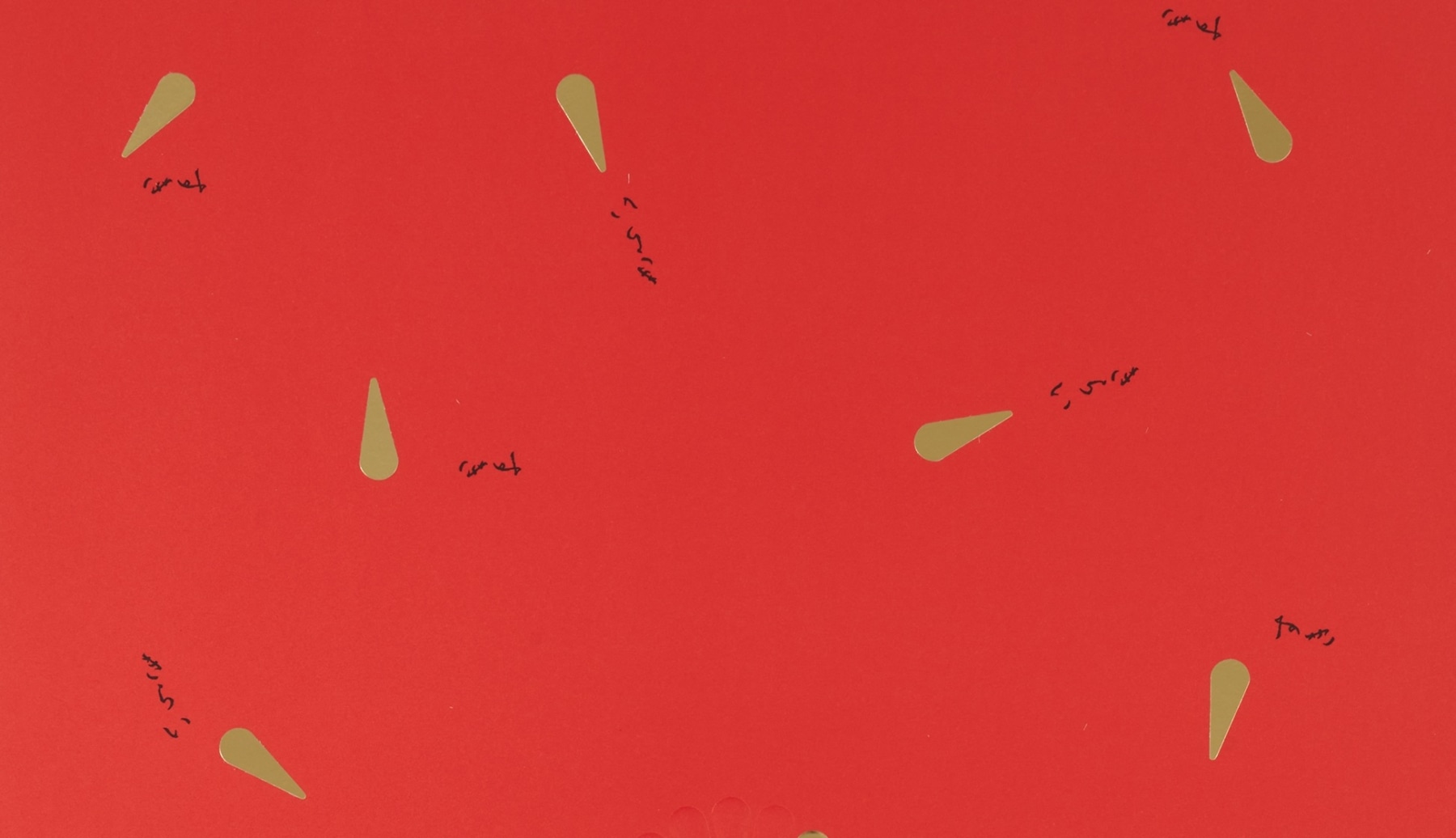
IFPDA Print Fair
Park Avenue Armory, New York
Booth A07
VIP Preview: March 27
Public Days: March 28 – 30
Alex Katz
Erik Lindman
David Rabinowitch
Luc Tuymans
Terry Winters
Yukinori Yanagi
Peter Blum Edition is pleased to be participating in the IFPDA Print Fair with a group presentation of historic published projects alongside prints by gallery artists.
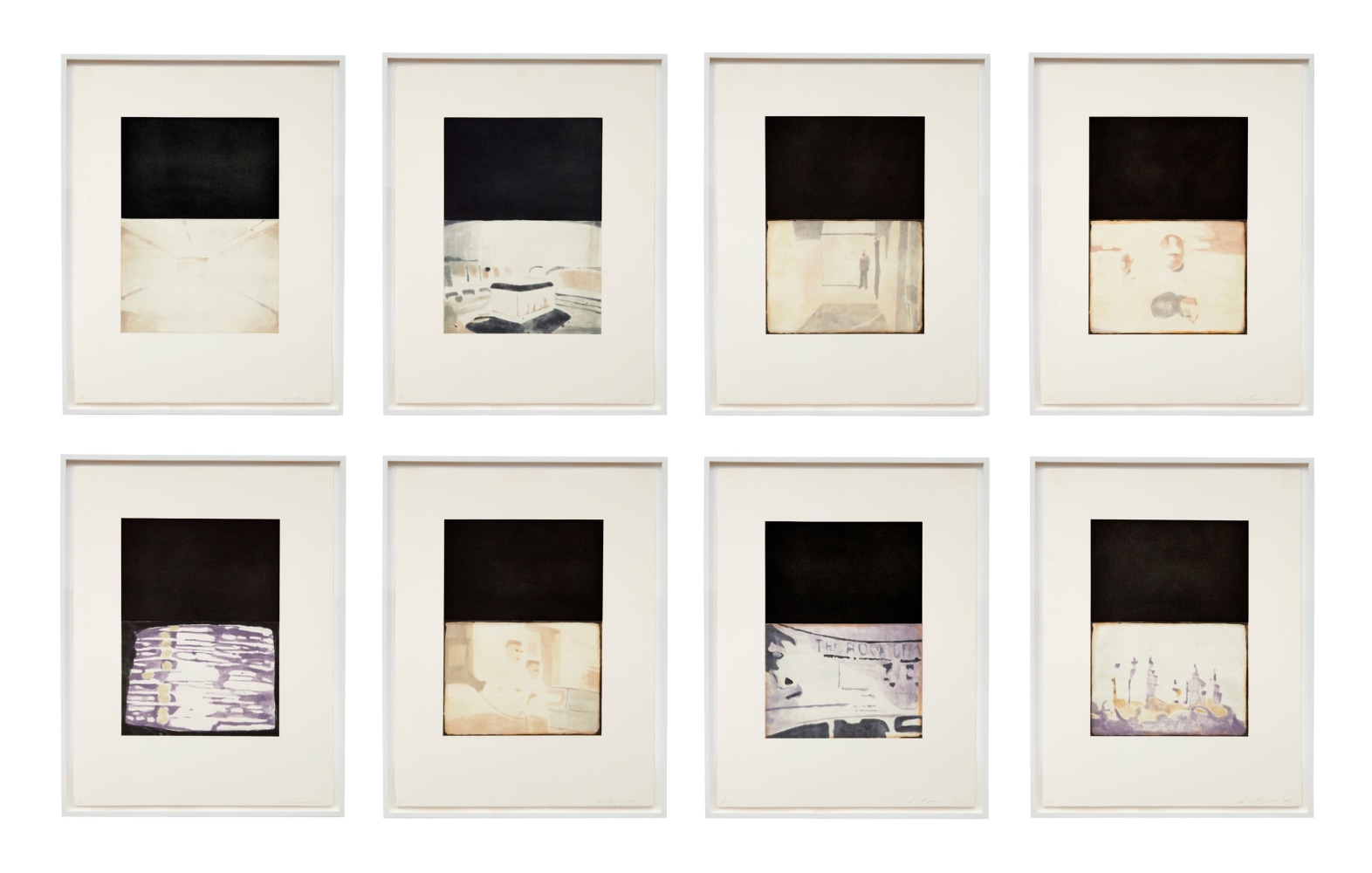
Luc Tuymans
The Temple, 1996
Portfolio of 8 aquatints and etchings on BFK Rives paper
31 1/2 x 23 3/4 inches (80 x 60.3 cm), each
Edition of 35 + APs
Printed by Peter Kneubühler, Zurich
Published by Peter Blum Edition
(LT96-46)
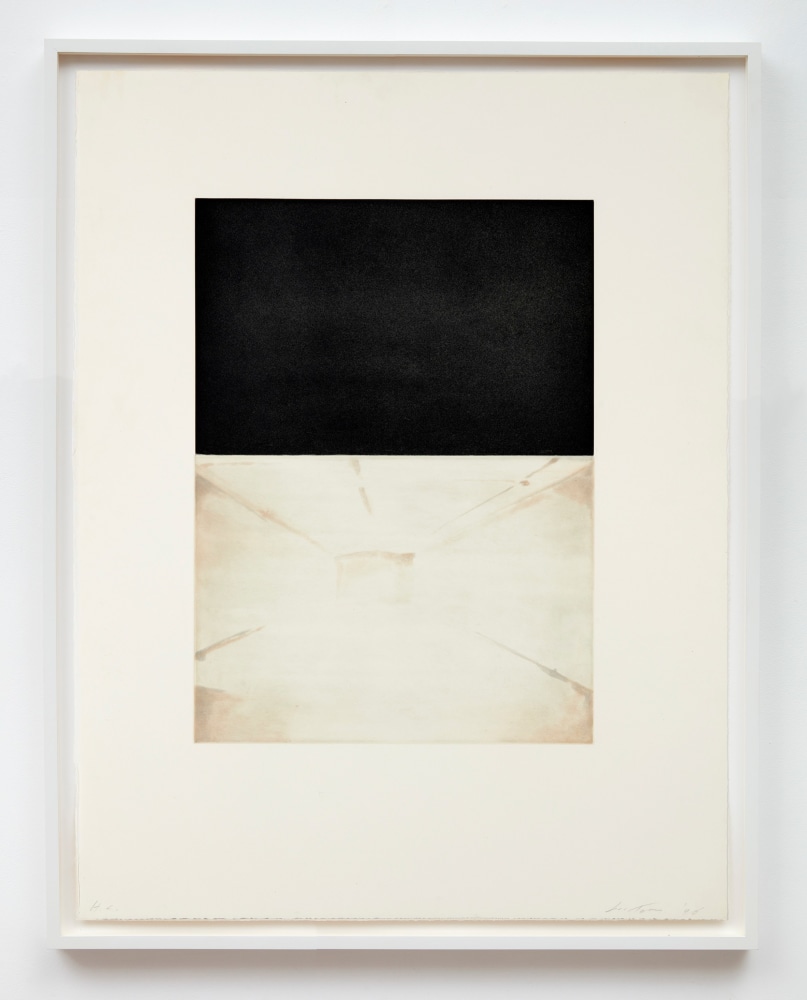
Luc Tuymans
The Temple, 1996
Portfolio of 8 aquatints and etchings on BFK Rives paper
31 1/2 x 23 3/4 inches (80 x 60.3 cm), each
Edition of 35 + APs
Printed by Peter Kneubühler, Zurich
Published by Peter Blum Edition
(LT96-46)
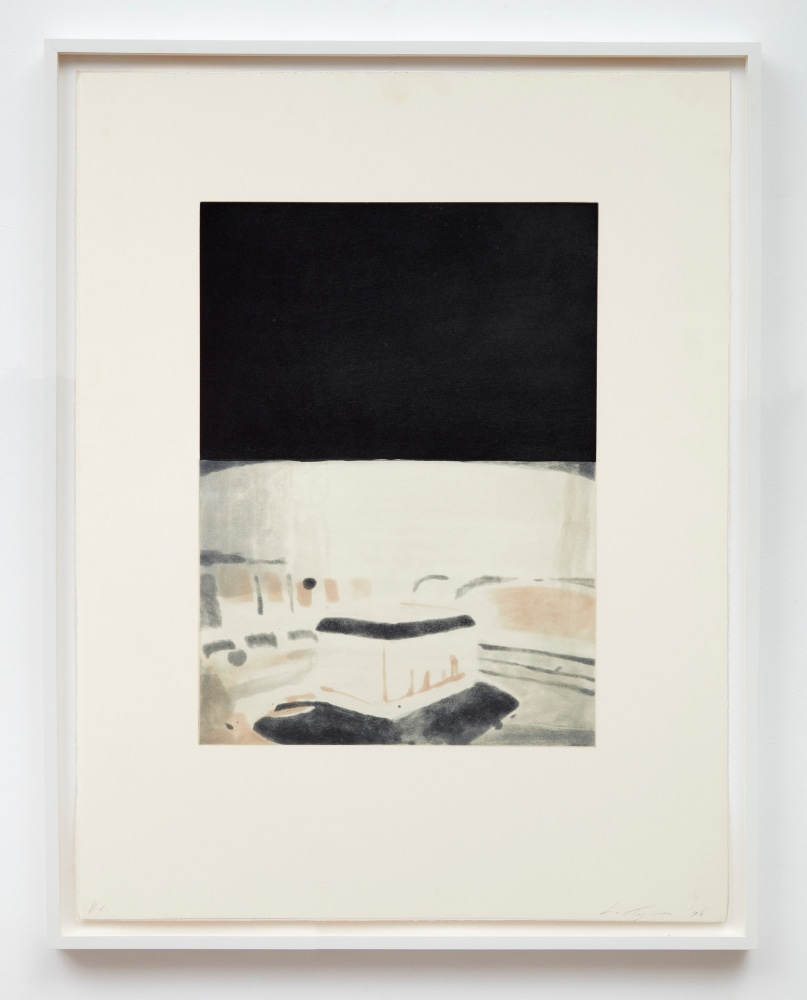
Luc Tuymans
The Temple, 1996
Portfolio of 8 aquatints and etchings on BFK Rives paper
31 1/2 x 23 3/4 inches (80 x 60.3 cm), each
Edition of 35 + APs
Printed by Peter Kneubühler, Zurich
Published by Peter Blum Edition
(LT96-46)
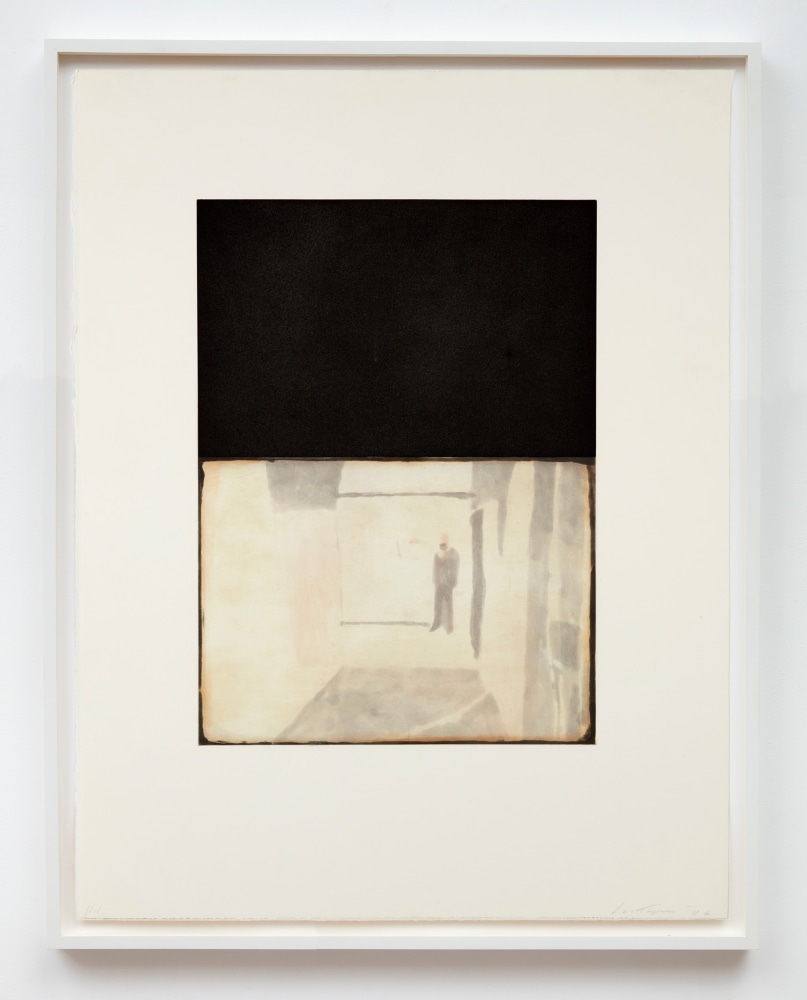
Luc Tuymans
The Temple, 1996
Portfolio of 8 aquatints and etchings on BFK Rives paper
31 1/2 x 23 3/4 inches (80 x 60.3 cm), each
Edition of 35 + APs
Printed by Peter Kneubühler, Zurich
Published by Peter Blum Edition
(LT96-46)
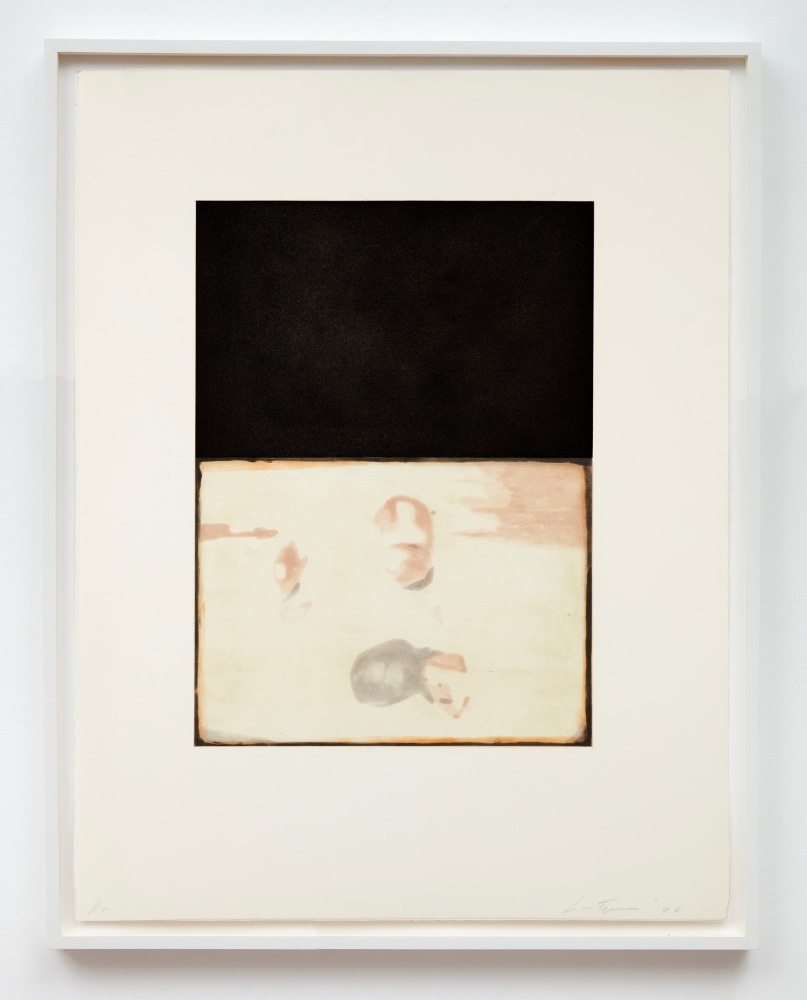
Luc Tuymans
The Temple, 1996
Portfolio of 8 aquatints and etchings on BFK Rives paper
31 1/2 x 23 3/4 inches (80 x 60.3 cm), each
Edition of 35 + APs
Printed by Peter Kneubühler, Zurich
Published by Peter Blum Edition
(LT96-46)
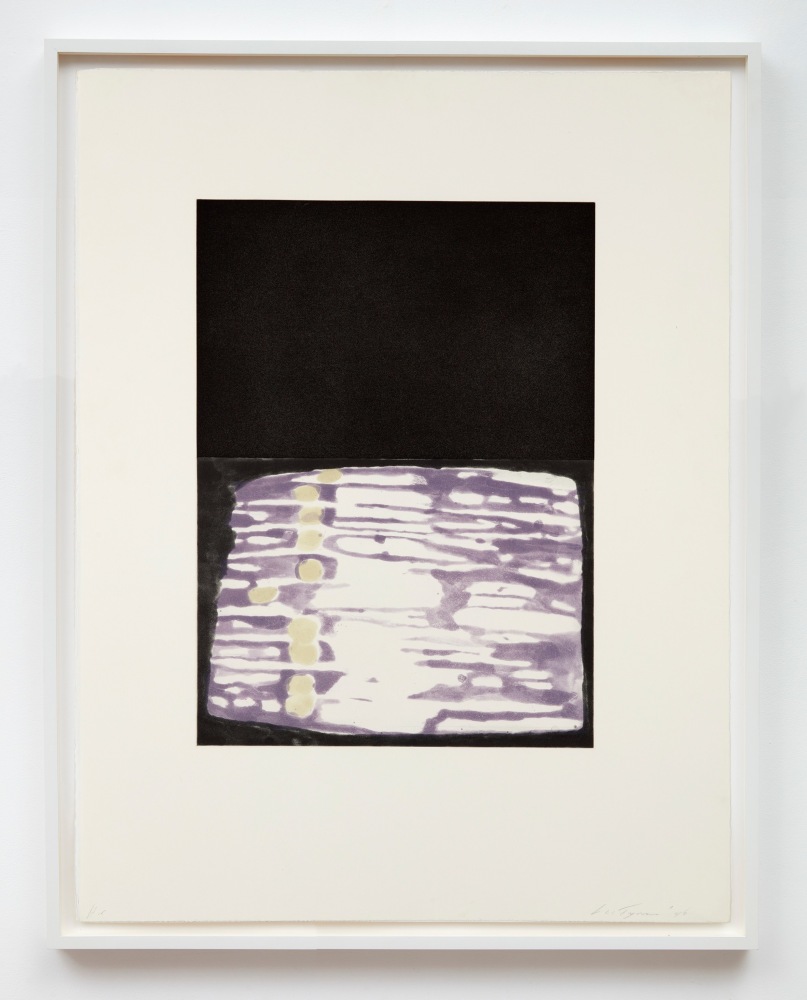
Luc Tuymans
The Temple, 1996
Portfolio of 8 aquatints and etchings on BFK Rives paper
31 1/2 x 23 3/4 inches (80 x 60.3 cm), each
Edition of 35 + APs
Printed by Peter Kneubühler, Zurich
Published by Peter Blum Edition
(LT96-46)
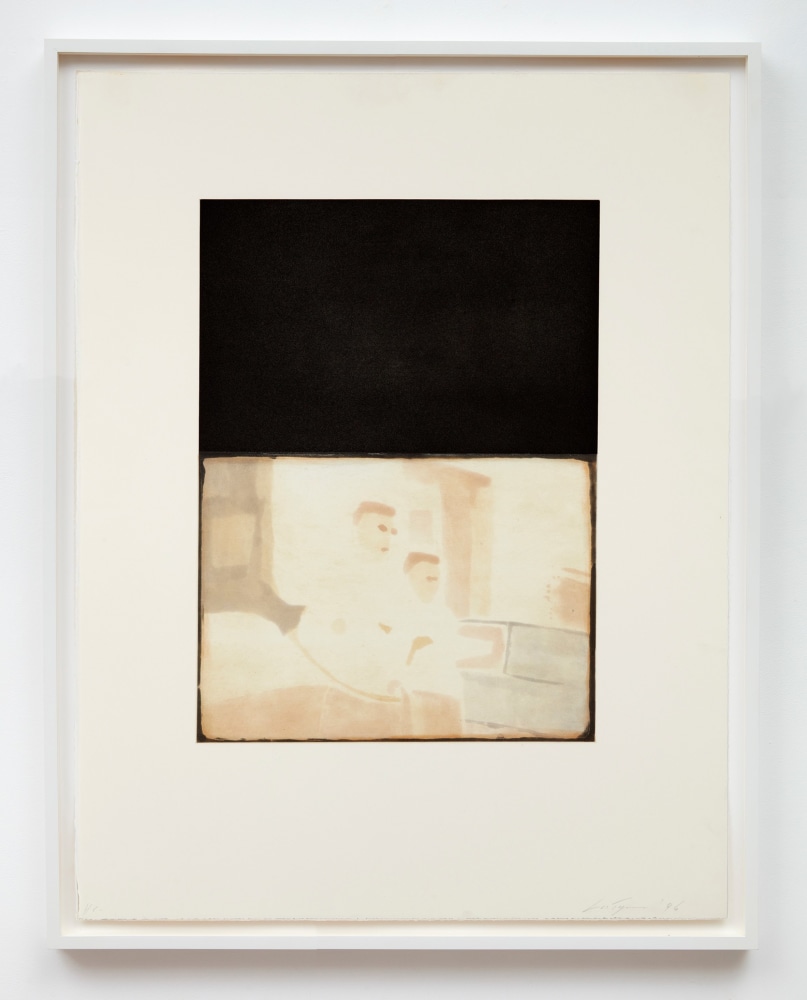
Luc Tuymans
The Temple, 1996
Portfolio of 8 aquatints and etchings on BFK Rives paper
31 1/2 x 23 3/4 inches (80 x 60.3 cm), each
Edition of 35 + APs
Printed by Peter Kneubühler, Zurich
Published by Peter Blum Edition
(LT96-46)
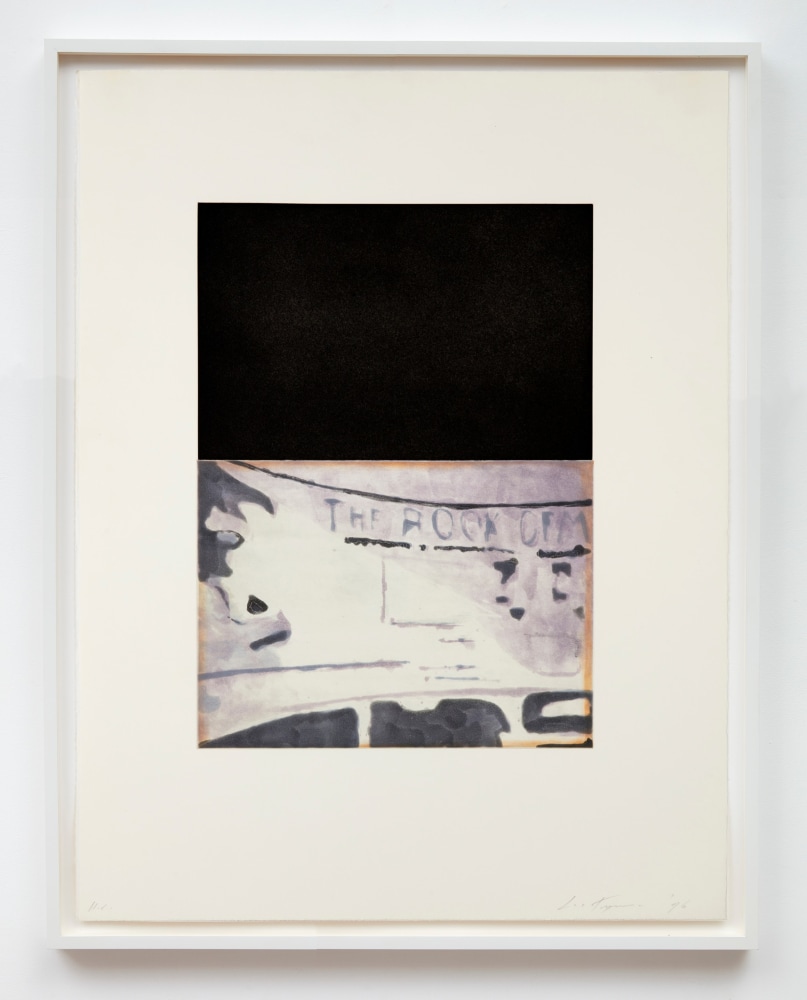
Luc Tuymans
The Temple, 1996
Portfolio of 8 aquatints and etchings on BFK Rives paper
31 1/2 x 23 3/4 inches (80 x 60.3 cm), each
Edition of 35 + APs
Printed by Peter Kneubühler, Zurich
Published by Peter Blum Edition
(LT96-46)
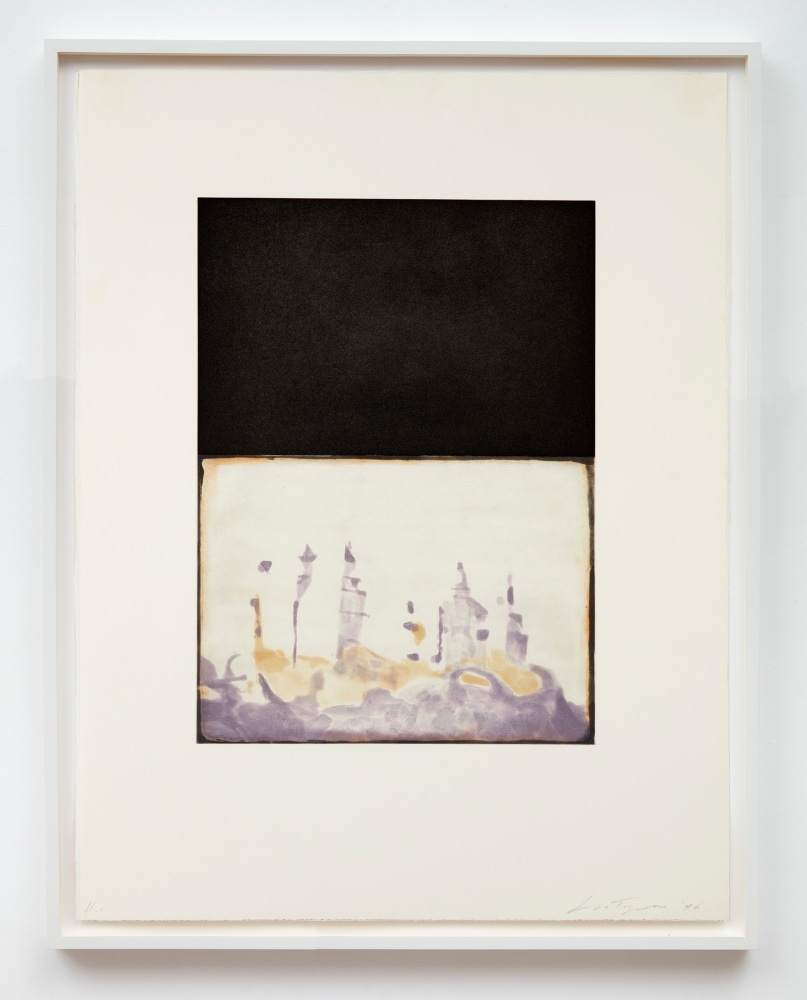
Luc Tuymans
The Temple, 1996
Portfolio of 8 aquatints and etchings on BFK Rives paper
31 1/2 x 23 3/4 inches (80 x 60.3 cm), each
Edition of 35 + APs
Printed by Peter Kneubühler, Zurich
Published by Peter Blum Edition
(LT96-46)
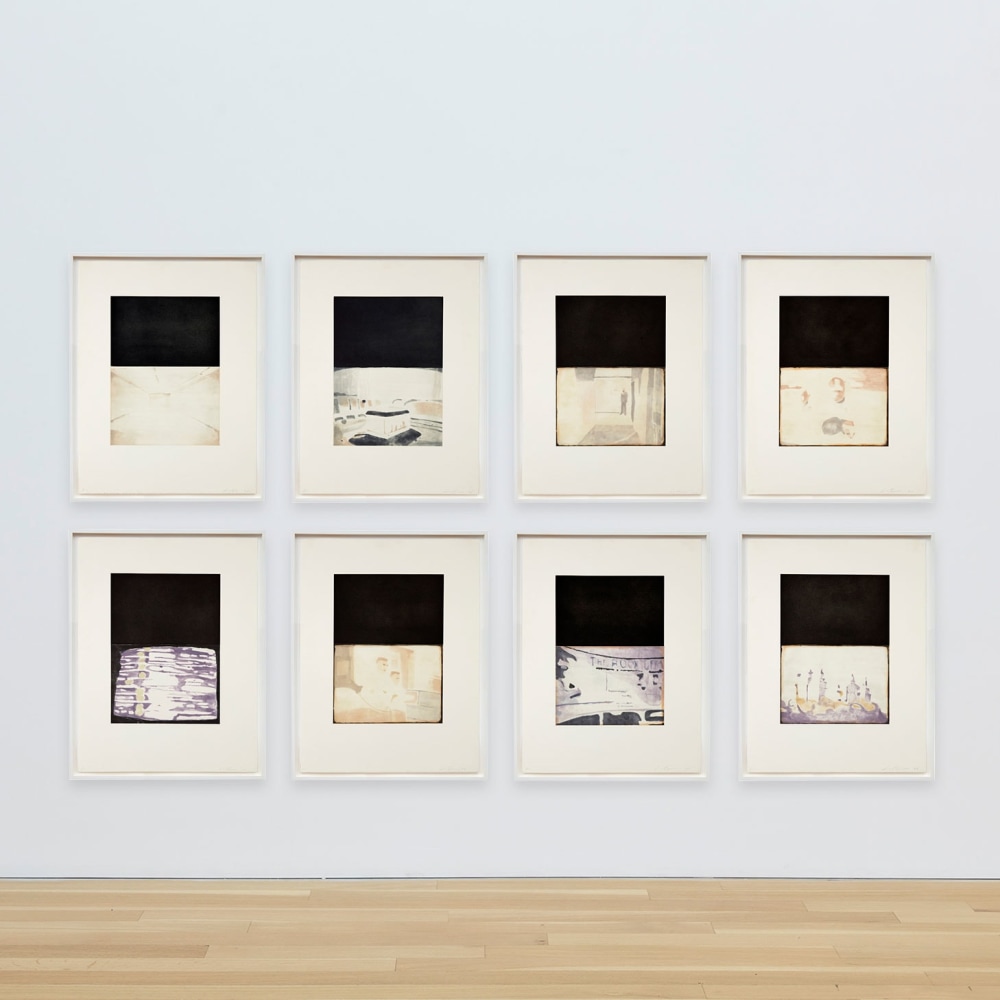
Luc Tuymans
The Temple, 1996
Portfolio of 8 aquatints and etchings on BFK Rives paper
31 1/2 x 23 3/4 inches (80 x 60.3 cm), each
Edition of 35 + APs
Printed by Peter Kneubühler, Zurich
Published by Peter Blum Edition
(LT96-46)
"Much of Luc Tuymans's work is influenced by cinema and television and by his own experiments with film and photography. 'For my generation, television is very important. There's a huge amount of visual information which can never be experienced but which can be seen, and its impact is enormous. I think it's almost impossible to make a universal image. One can only make bits of images. Existence looks edited ... After seeing a film I try to figure out which single image is the one with which I can remember all the moving images of the movie.'
Tuymans used a television documentary film as the source of the portfolio of prints called The Temple. The subject of the documentary was the Mormon religion in the United States. Tuymans recorded the programme on video and took photographic stills from the television screen. He produced a series of watercolours based on these stills and then photographed these with a Polaroid camera. He then took Polaroid pictures of the first set of Polaroids and, finally, painted another group of watercolours based on the second set of Polaroids. These watercolours were used as the studies for the resulting prints. When interviewed about the separate stages used in making these prints, Tuymans described how 'they are all representations of representations, so the material used is always based upon a memory of materials, or memorised imagery, which means that the imagery is always third rate'. The dark rectangles and contrasting lighter images in the final prints can be read as evoking the original source of the television screen, blank and dark when not in use, and emitting flickering light when switched on.
Since 1995, American subjects and imagery have been a feature of Tuymans's work. He has stated that in focusing on the 'super-American subject' of the Mormon religion, it was his intention to reveal the secular social structures and highly organised, almost profane, character of this 'religious FBI.'"
– Michela Parkin, Tate Modern, 1997
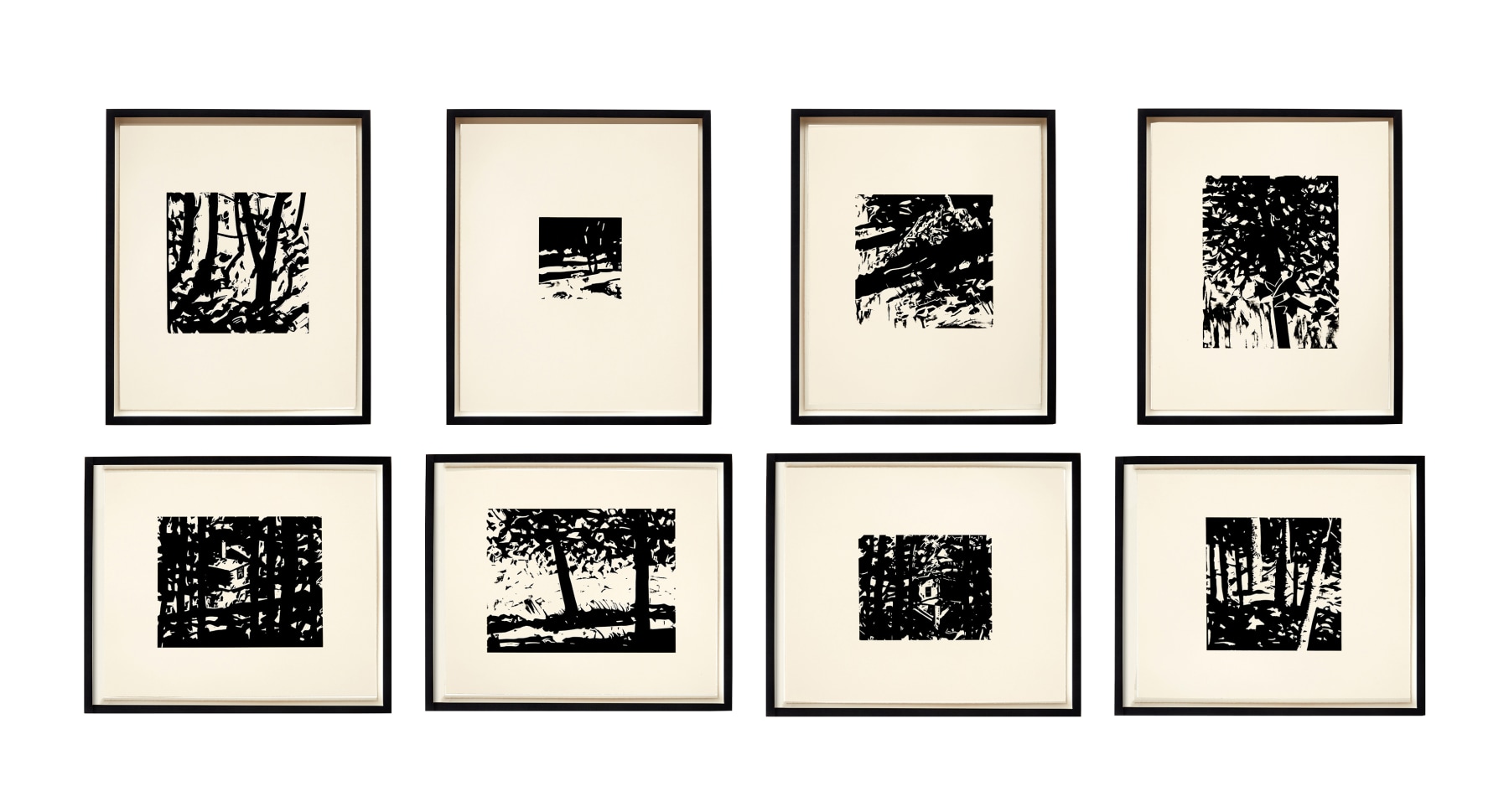
Alex Katz
Landscape, 2001
Portfolio of 8 linocuts on Stonehenge paper
16 3/4 x 13 7/8 inches (42.6 x 35.2 cm), each
Edition of 45 + APs
Printed by Chris Erickson, Brooklyn, NY
Published by Peter Blum Edition
(AK01-75)
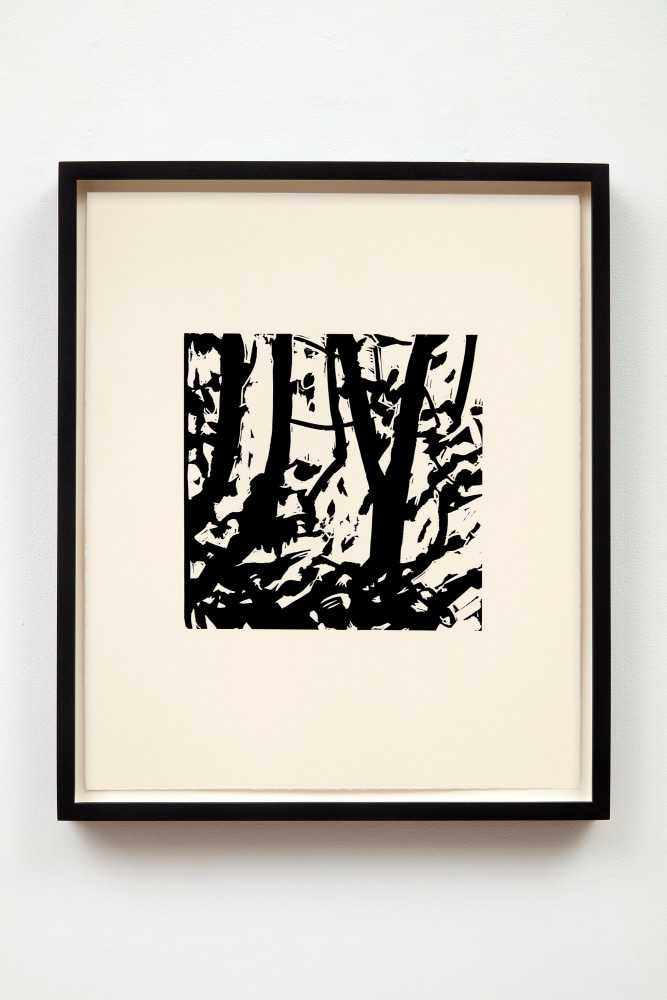
Alex Katz
Landscape, 2001
Portfolio of 8 linocuts on Stonehenge paper
16 3/4 x 13 7/8 inches (42.6 x 35.2 cm), each
Edition of 45 + APs
Printed by Chris Erickson, Brooklyn, NY
Published by Peter Blum Edition
(AK01-75)
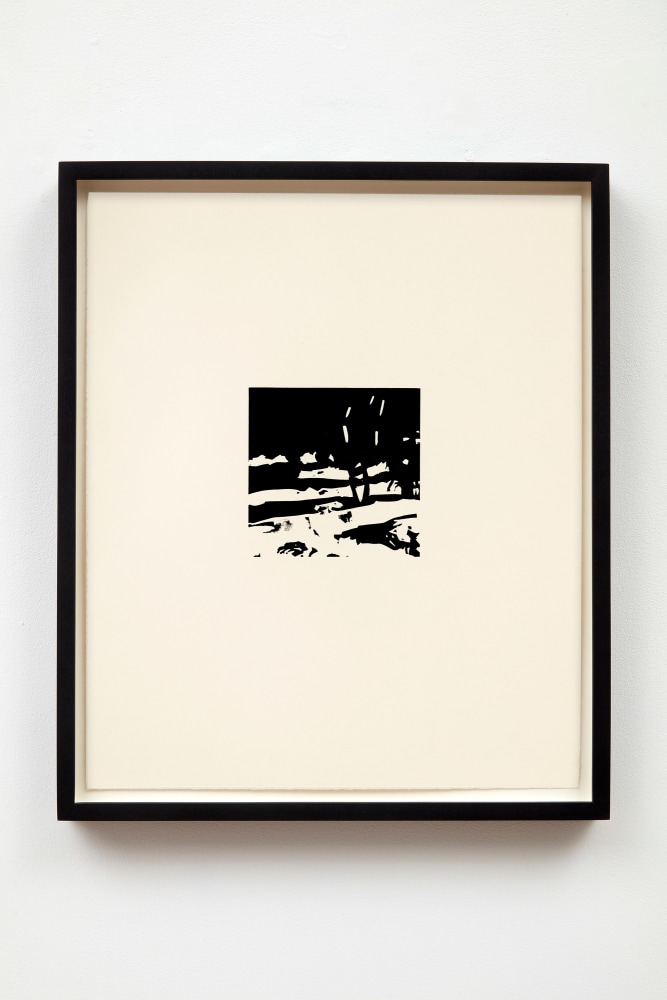
Alex Katz
Landscape, 2001
Portfolio of 8 linocuts on Stonehenge paper
16 3/4 x 13 7/8 inches (42.6 x 35.2 cm), each
Edition of 45 + APs
Printed by Chris Erickson, Brooklyn, NY
Published by Peter Blum Edition
(AK01-75)
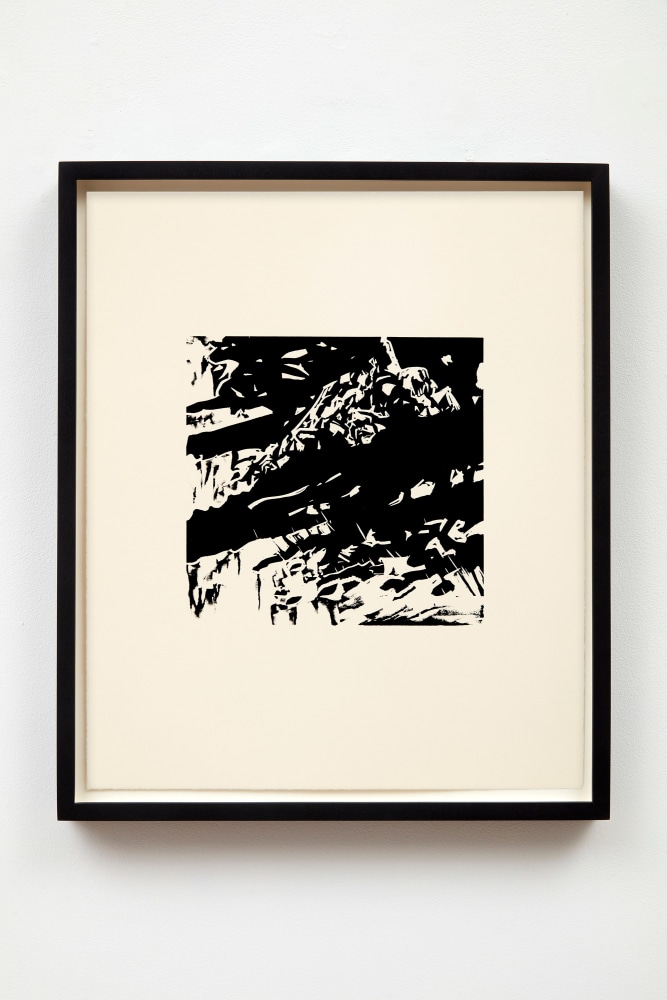
Alex Katz
Landscape, 2001
Portfolio of 8 linocuts on Stonehenge paper
16 3/4 x 13 7/8 inches (42.6 x 35.2 cm), each
Edition of 45 + APs
Printed by Chris Erickson, Brooklyn, NY
Published by Peter Blum Edition
(AK01-75)
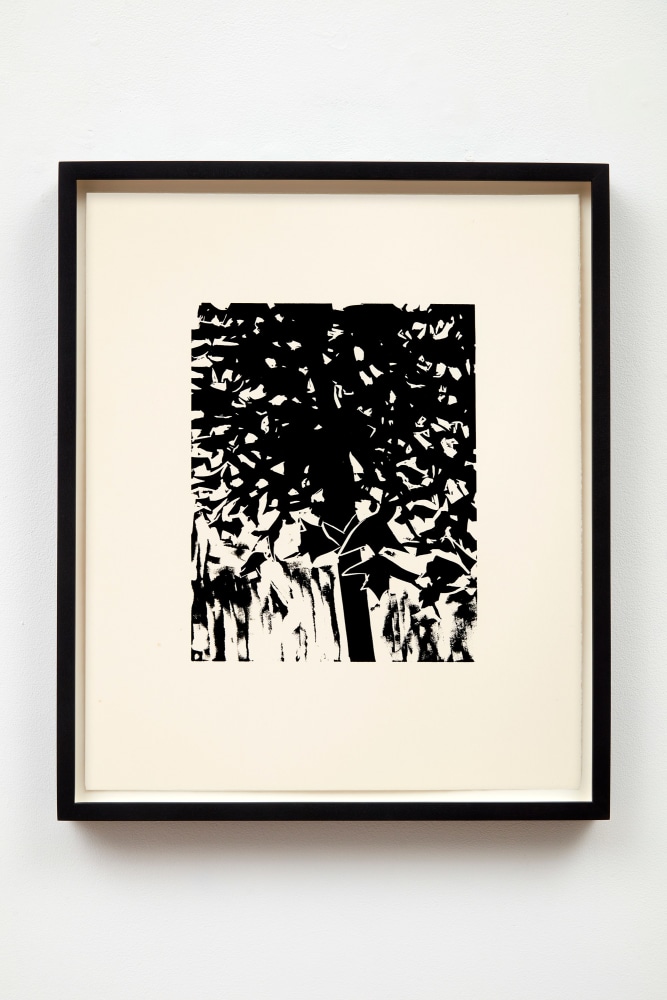
Alex Katz
Landscape, 2001
Portfolio of 8 linocuts on Stonehenge paper
16 3/4 x 13 7/8 inches (42.6 x 35.2 cm), each
Edition of 45 + APs
Printed by Chris Erickson, Brooklyn, NY
Published by Peter Blum Edition
(AK01-75)
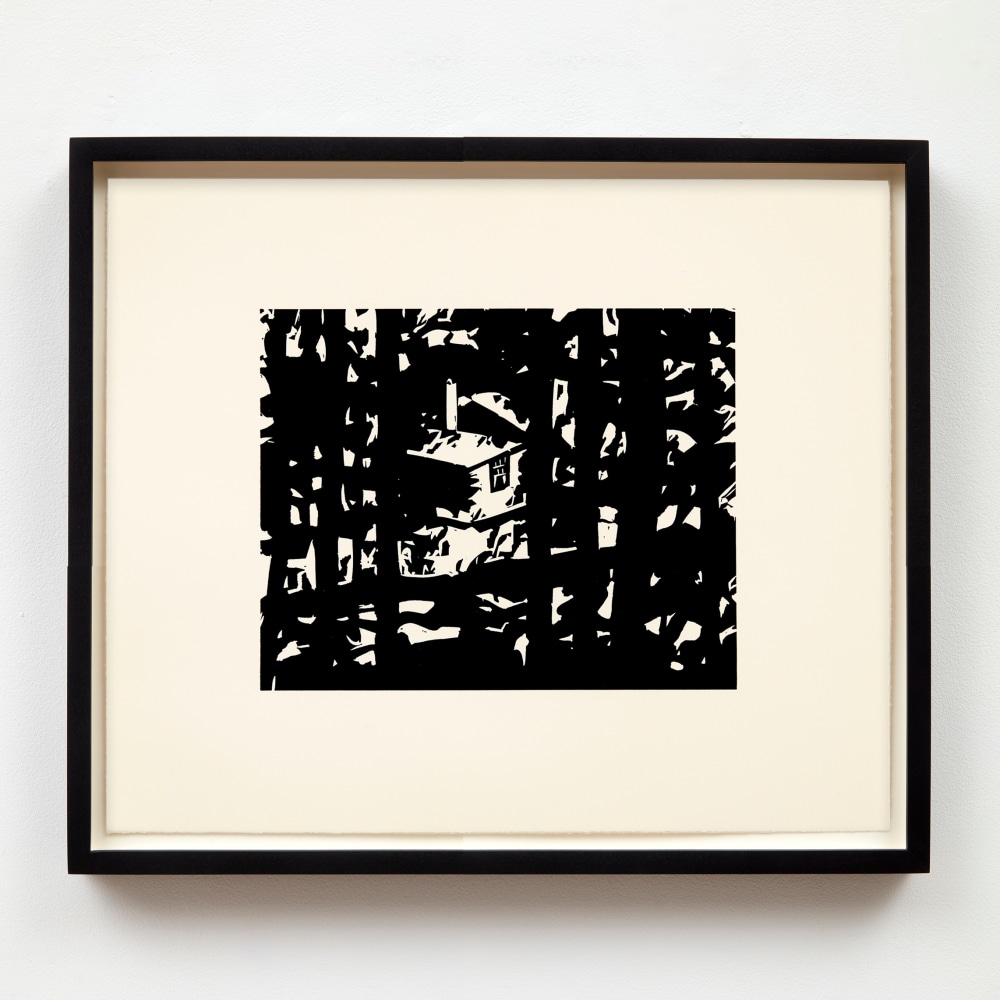
Alex Katz
Landscape, 2001
Portfolio of 8 linocuts on Stonehenge paper
16 3/4 x 13 7/8 inches (42.6 x 35.2 cm), each
Edition of 45 + APs
Printed by Chris Erickson, Brooklyn, NY
Published by Peter Blum Edition
(AK01-75)
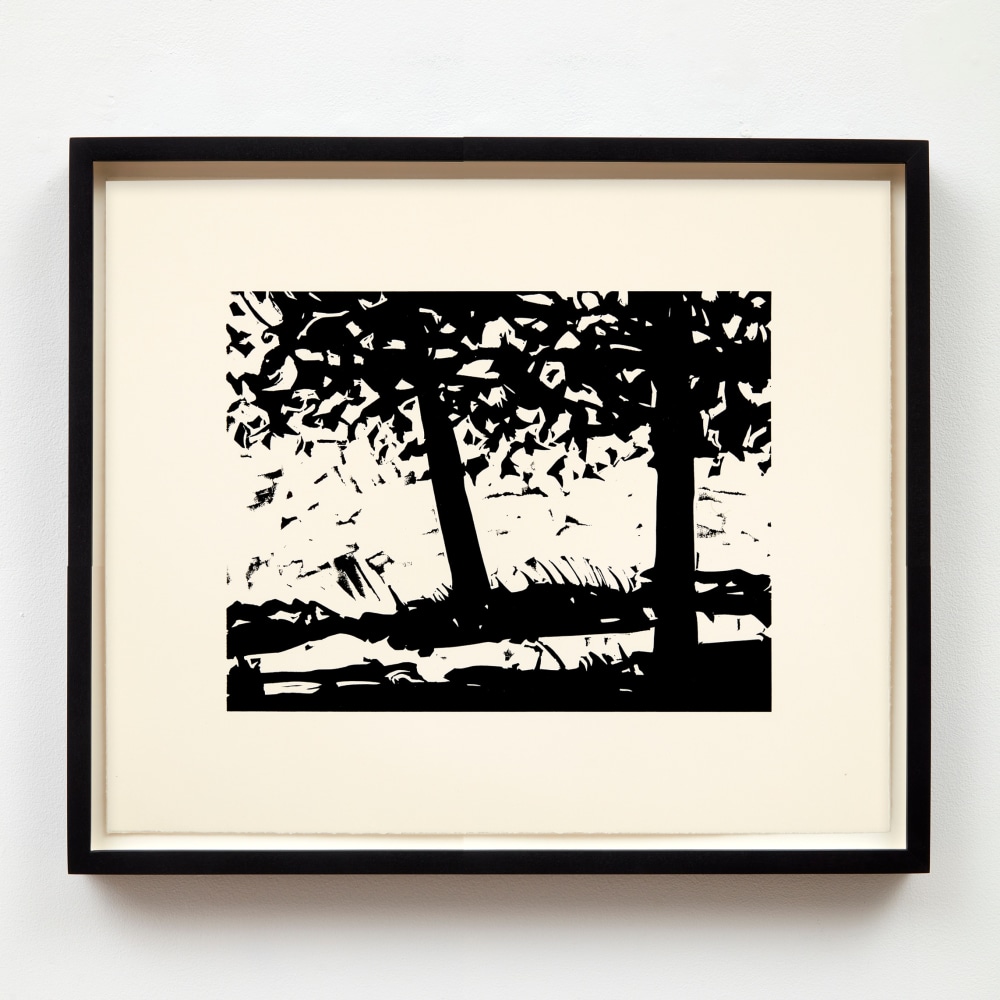
Alex Katz
Landscape, 2001
Portfolio of 8 linocuts on Stonehenge paper
16 3/4 x 13 7/8 inches (42.6 x 35.2 cm), each
Edition of 45 + APs
Printed by Chris Erickson, Brooklyn, NY
Published by Peter Blum Edition
(AK01-75)
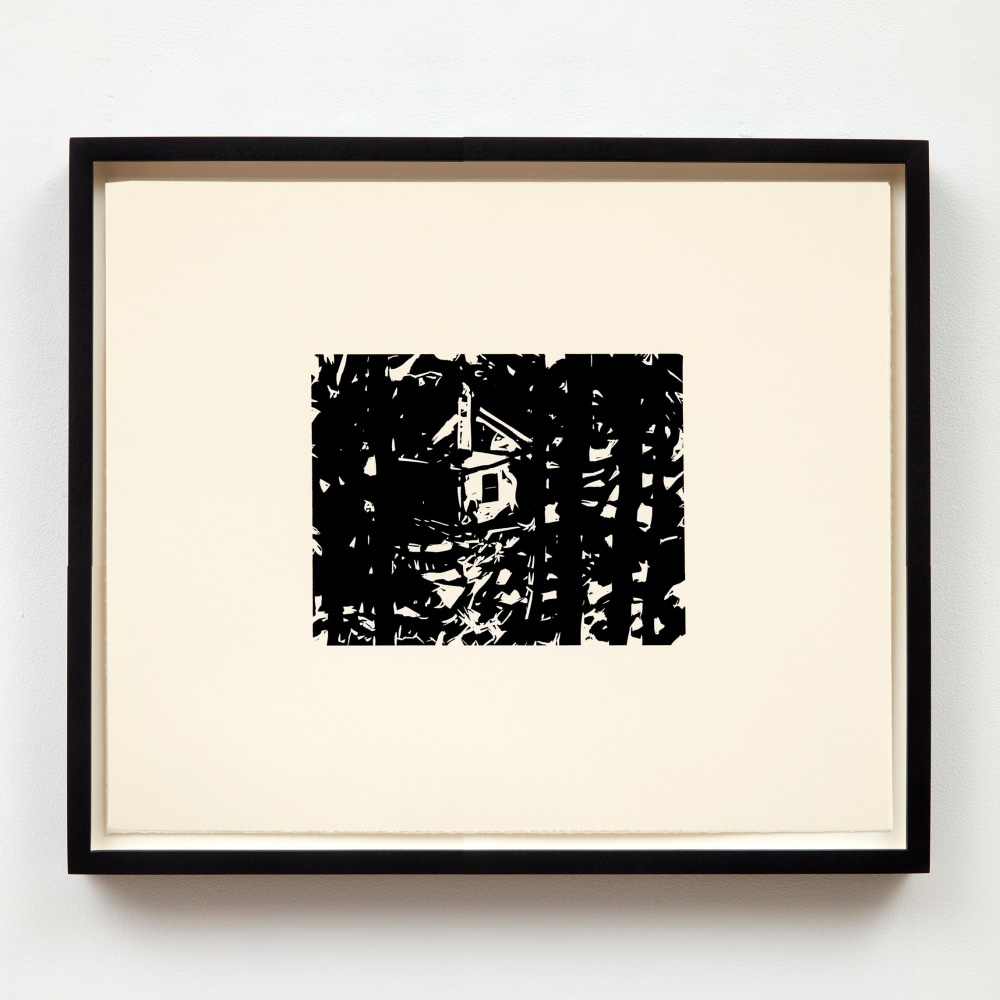
Alex Katz
Landscape, 2001
Portfolio of 8 linocuts on Stonehenge paper
16 3/4 x 13 7/8 inches (42.6 x 35.2 cm), each
Edition of 45 + APs
Printed by Chris Erickson, Brooklyn, NY
Published by Peter Blum Edition
(AK01-75)
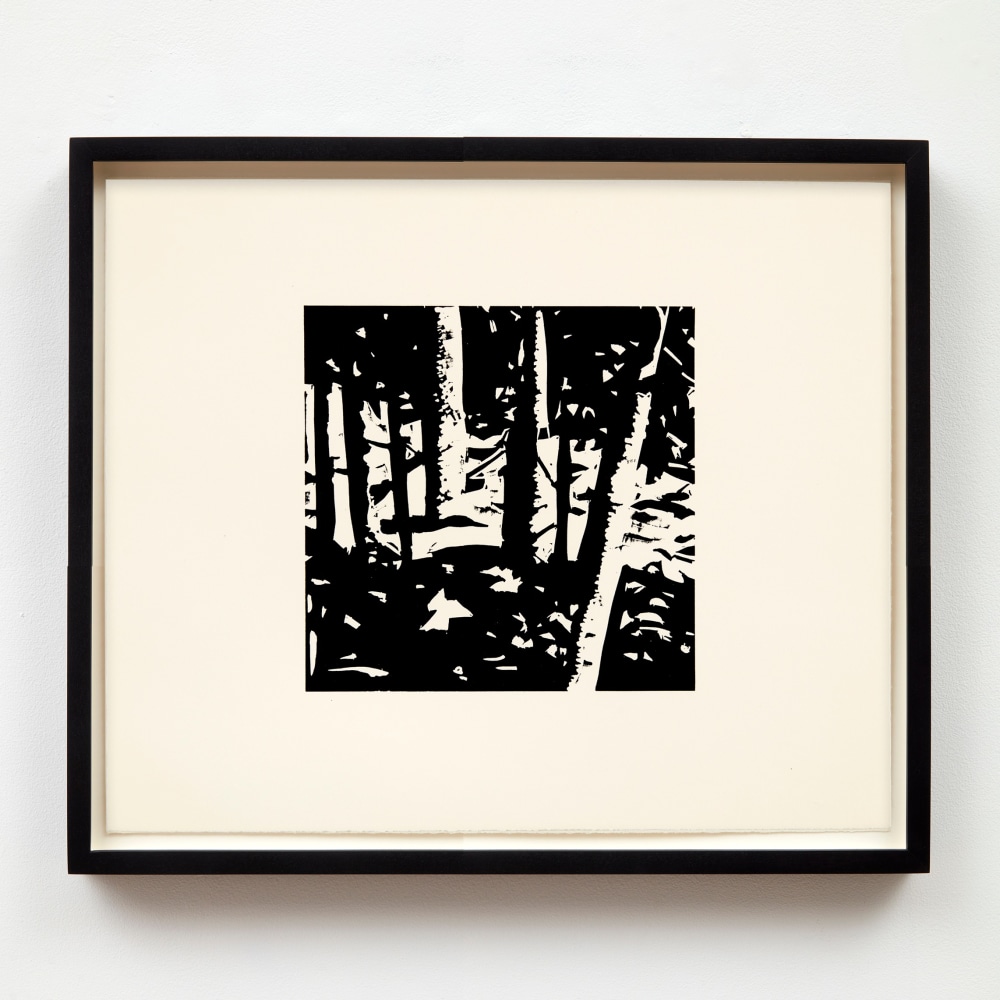
Alex Katz
Landscape, 2001
Portfolio of 8 linocuts on Stonehenge paper
16 3/4 x 13 7/8 inches (42.6 x 35.2 cm), each
Edition of 45 + APs
Printed by Chris Erickson, Brooklyn, NY
Published by Peter Blum Edition
(AK01-75)
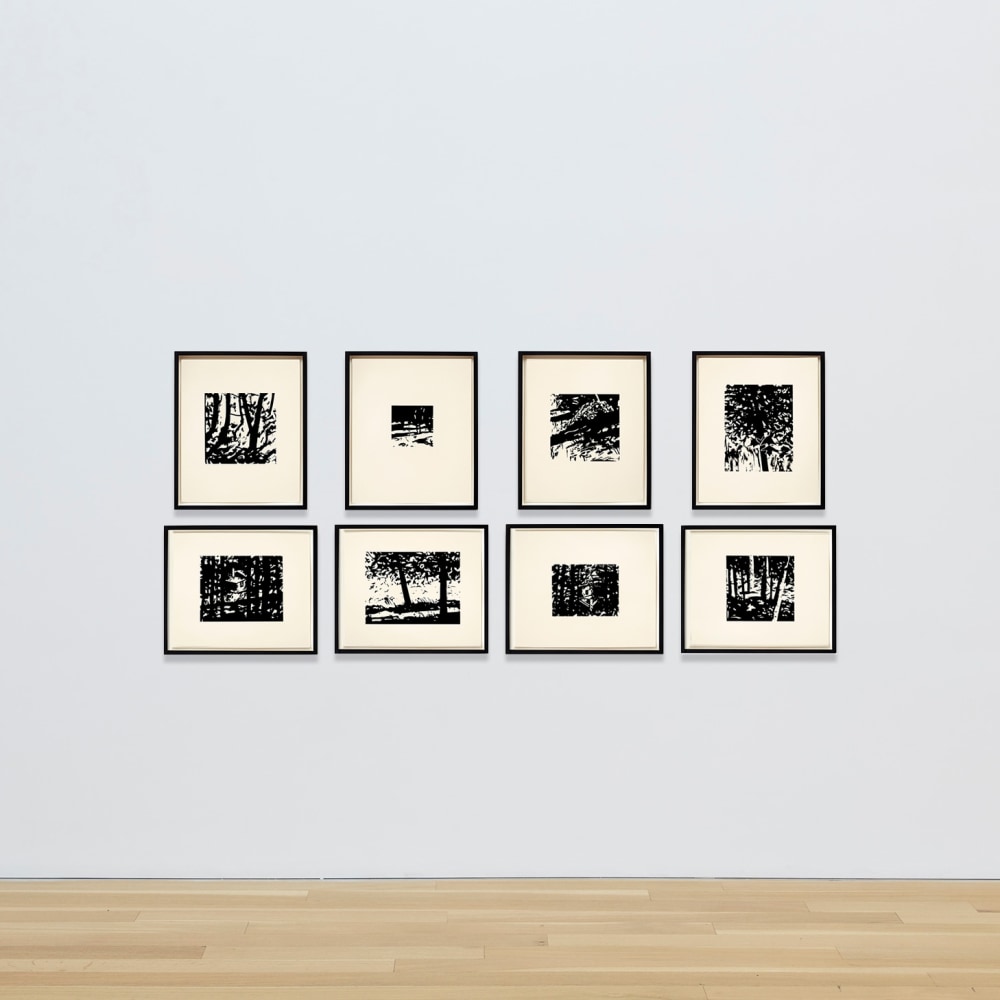
Alex Katz
Landscape, 2001
Portfolio of 8 linocuts on Stonehenge paper
16 3/4 x 13 7/8 inches (42.6 x 35.2 cm), each
Edition of 45 + APs
Printed by Chris Erickson, Brooklyn, NY
Published by Peter Blum Edition
(AK01-75)
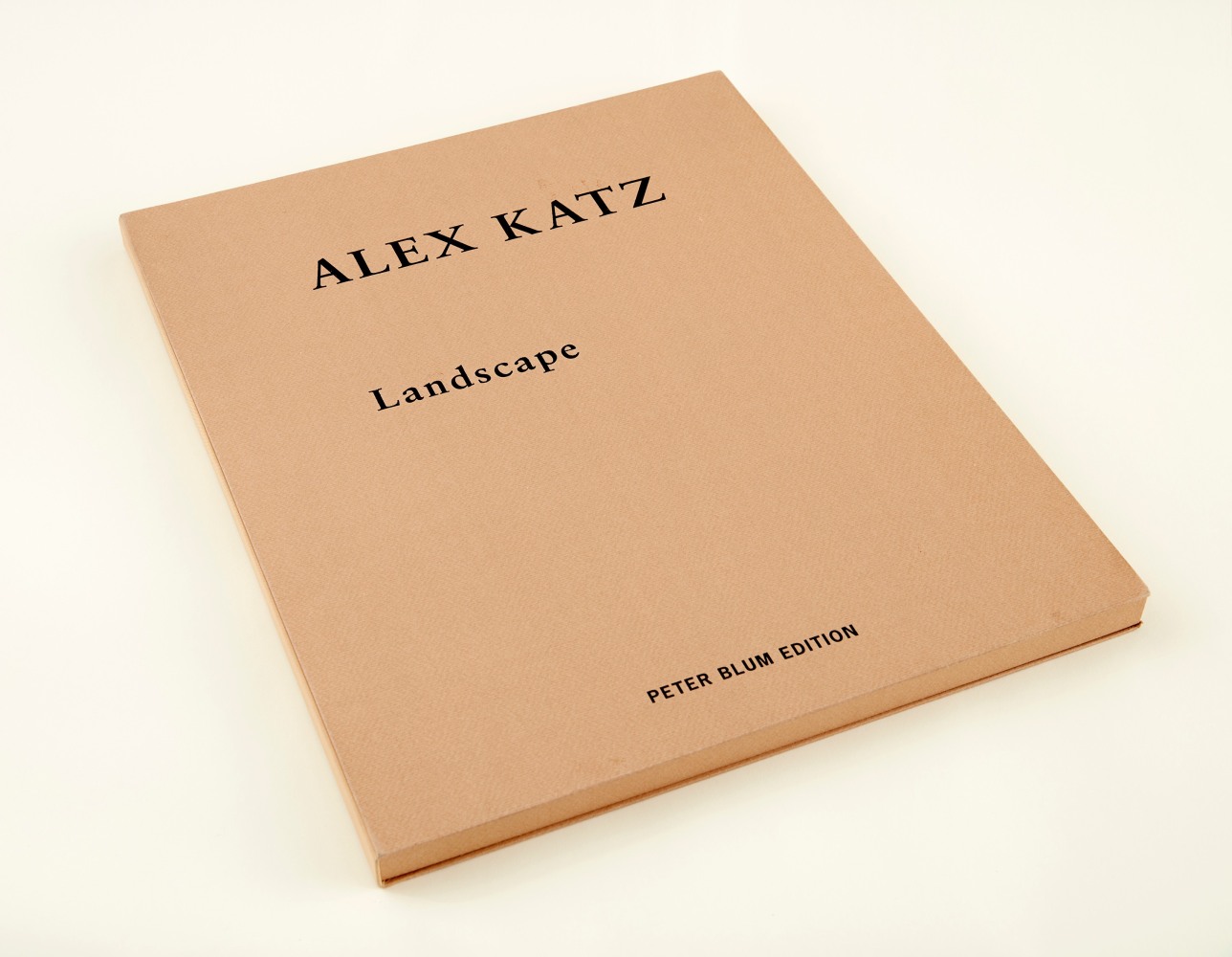
Alex Katz
Landscape, 2001
Portfolio of 8 linocuts on Stonehenge paper
16 3/4 x 13 7/8 inches (42.6 x 35.2 cm), each
Edition of 45 + APs
Printed by Chris Erickson, Brooklyn, NY
Published by Peter Blum Edition
(AK01-75)
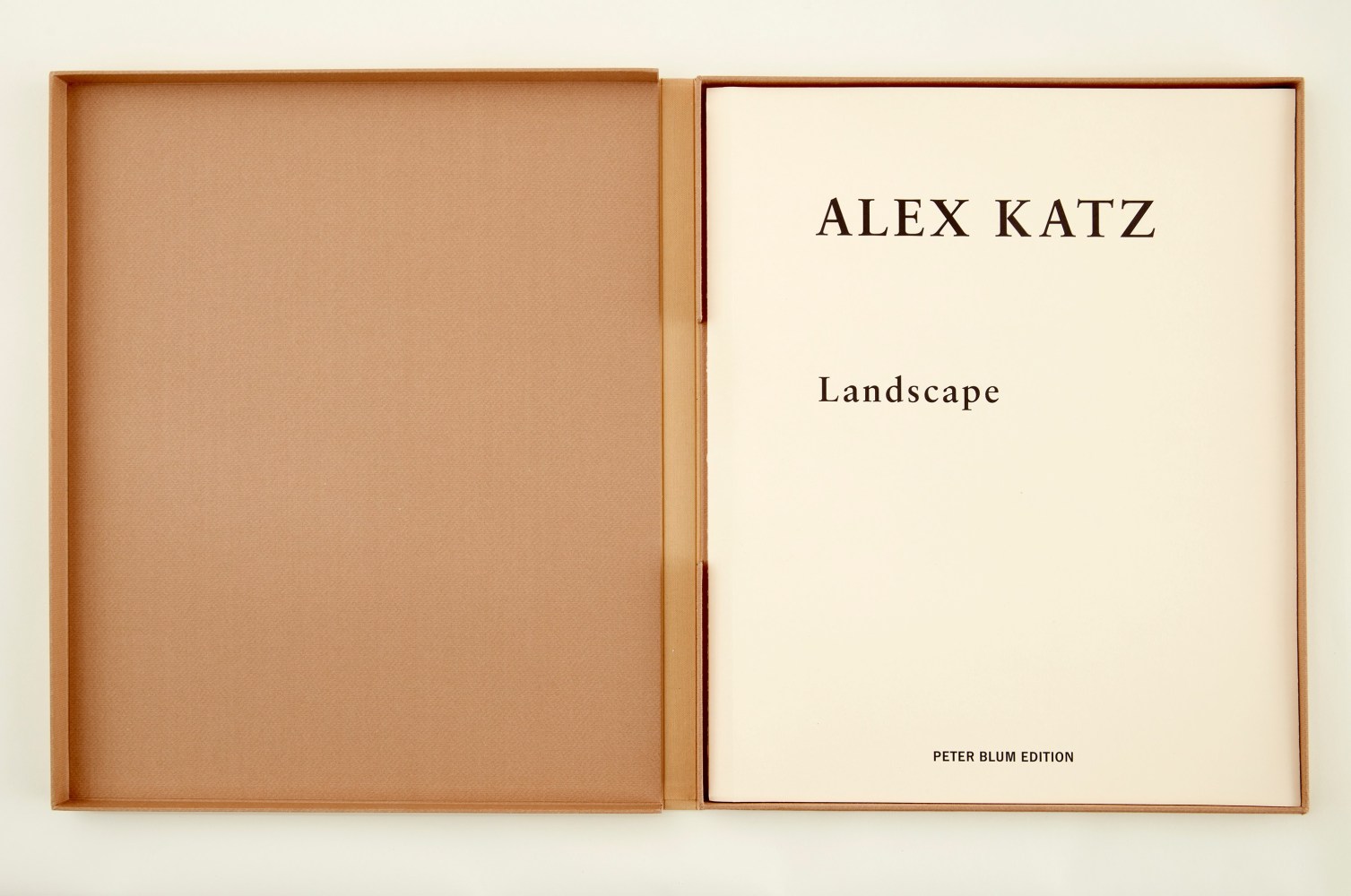
Alex Katz
Landscape, 2001
Portfolio of 8 linocuts on Stonehenge paper
16 3/4 x 13 7/8 inches (42.6 x 35.2 cm), each
Edition of 45 + APs
Printed by Chris Erickson, Brooklyn, NY
Published by Peter Blum Edition
(AK01-75)
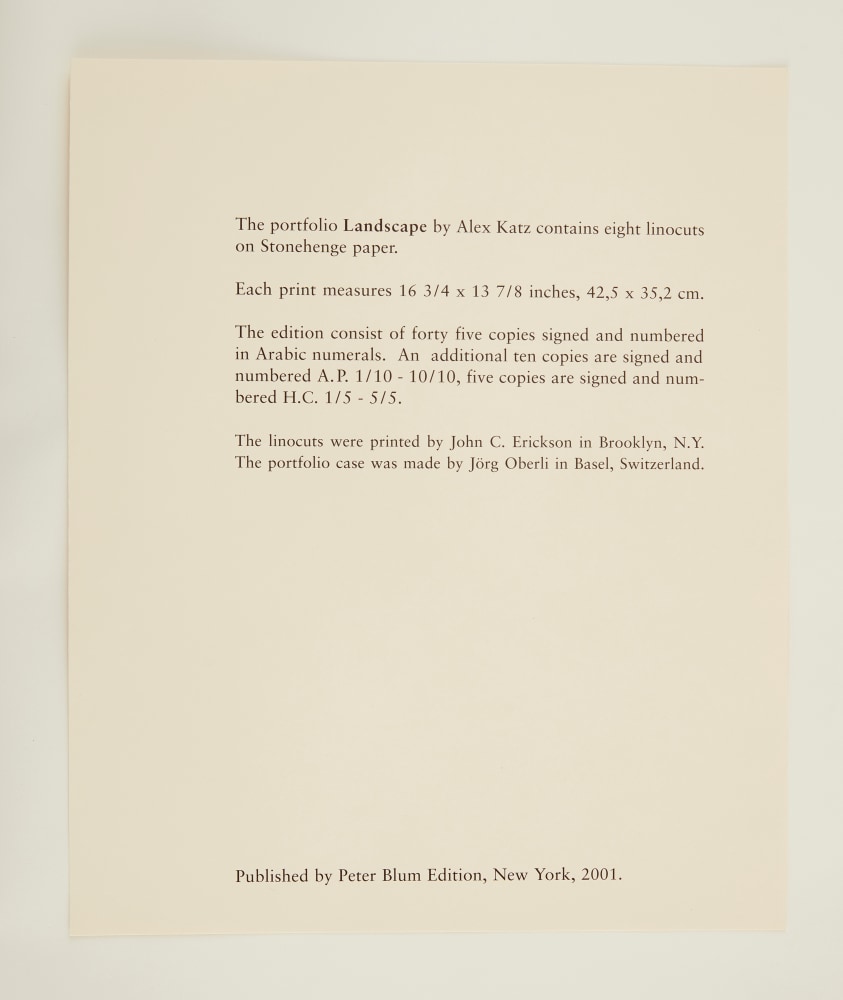
Alex Katz
Landscape, 2001
Portfolio of 8 linocuts on Stonehenge paper
16 3/4 x 13 7/8 inches (42.6 x 35.2 cm), each
Edition of 45 + APs
Printed by Chris Erickson, Brooklyn, NY
Published by Peter Blum Edition
(AK01-75)
“It was in 1986 that I first proposed to Alex Katz that we collaborate on a print project. Rarely, in my years as a publisher, have I been as clear as to the technique I wanted to suggest to an artist. It was evident to me that the medium should be relief print: wood or linocut. I sensed that in this deceptively simple print technique the more intimate and intuitive qualities of Katz's work would come into play.
It was only later - and with some surprise - I discovered that his very first prints had included wood and linoblocks over thirty years earlier, but that he had not used the technique since. Encouraged to return to this direct and visceral medium, Katz created the images for the portfolio A Tremor in the Morning. The suite of ten woodcuts won over many who (especially in Europe) had not previously appreciated his work. Indeed, the growing awareness of Katz's prints (as of his drawings and smaller oils) has been instrumental in a major reassessment of this artist.
Last year Alex Katz called me at the end of the summer, telling me excitedly about twelve linocuts he had just completed at his studio in Maine [Landscape among them]. ‘I suddenly had this intense desire, this urge to cut into wood or linoleum,’ he told me, ‘but I didn't have any blocks or tools. So, I went to the local supply store in Camden where I bought the kind of print kit intended for the beginner or the sixth-grade art class student who wants to learn how to cut a linoleum block. I went to work fast and furiously and couldn't stop until I had used up all the blocks.’ The resulting landscapes, done in black and white, in some ways hark back to Katz's early work, but seem less raw without losing the energy, and clearly convey the insight and experience of a fifty-year career.”
– Peter Blum, Alex Katz: The Woodcuts and Linocuts, 2001
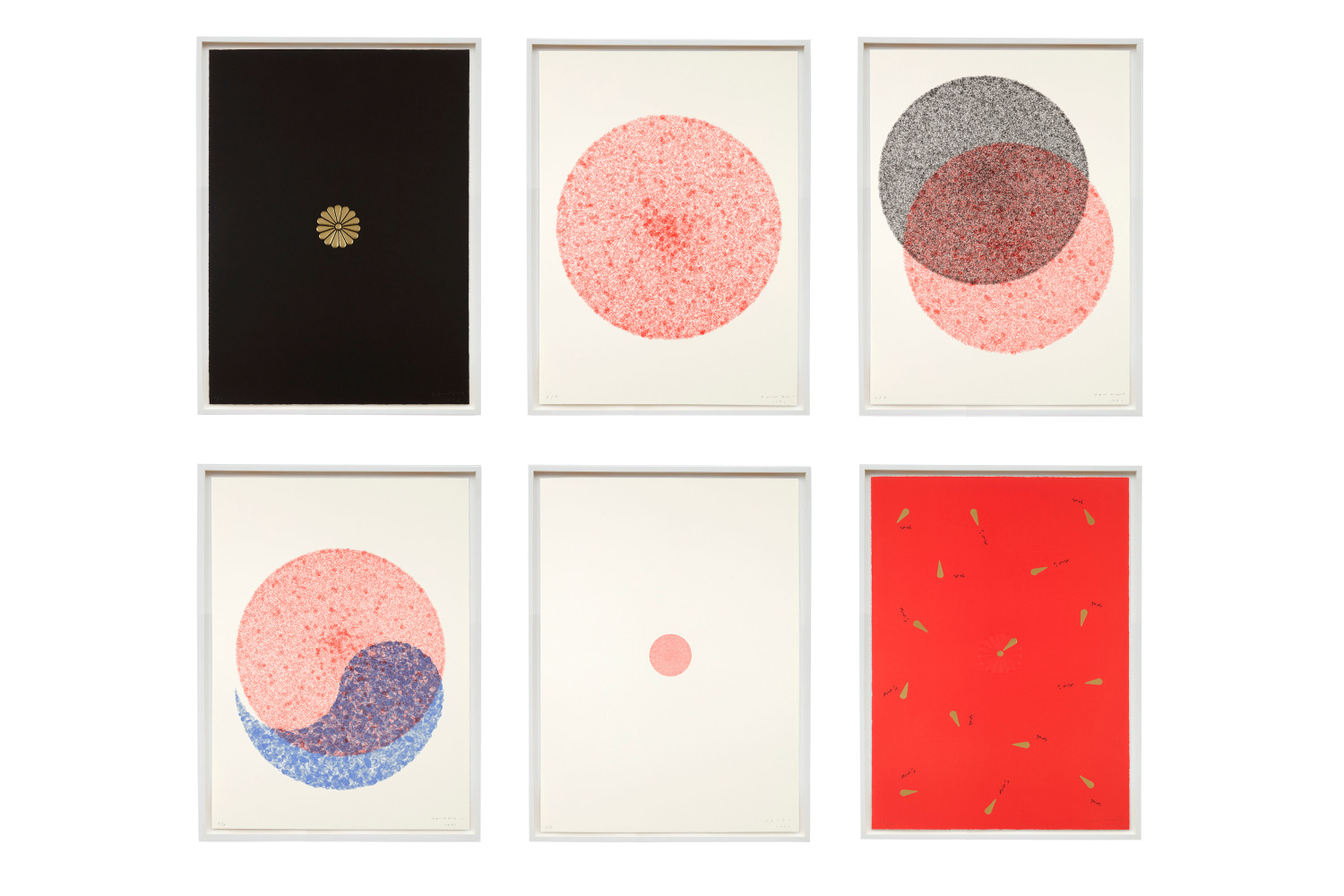
Yukinori Yanagi
Hinomaru, 1991
Portfolio of 6 lithographs with embossing and collage on paper
33 x 24 inches (83.8 x 61 cm), each
Edition of 35 + APs
Printed by Maurice Sanchez, New York, NY
Published by Peter Blum Edition
(YY91-45)
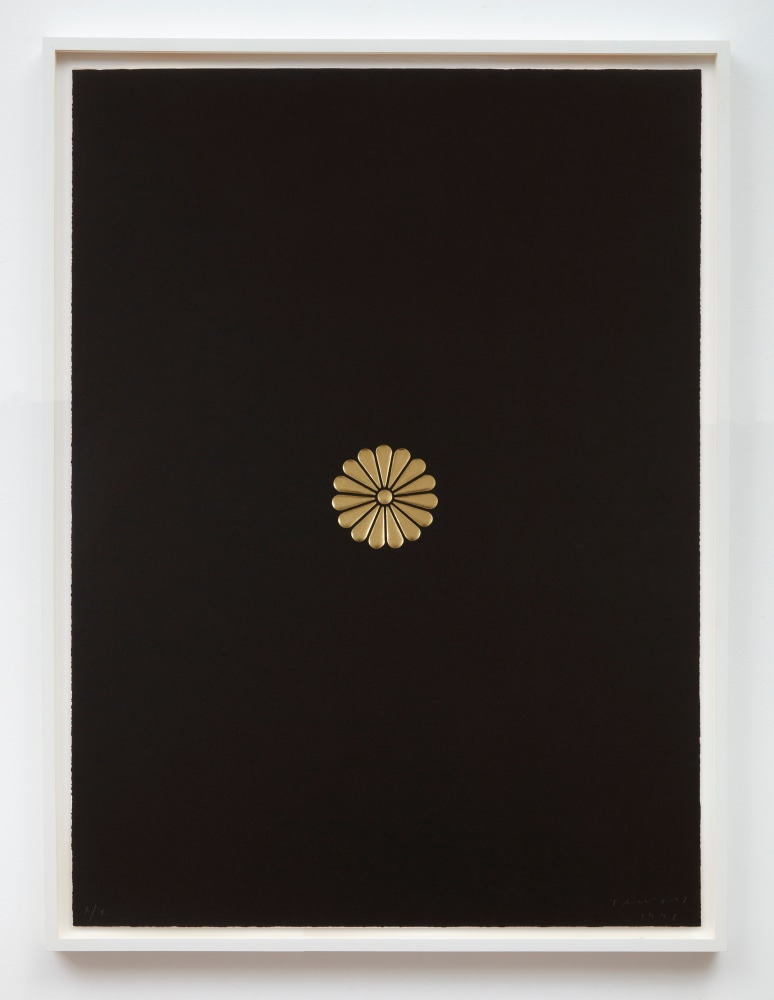
Yukinori Yanagi
Emperor's Seal from: Hinomaru, 1991
Portfolio of 6 lithographs with embossing and collage on paper
33 x 24 inches (83.8 x 61 cm), each
Edition of 35 + APs
Printed by Maurice Sanchez, New York, NY
Published by Peter Blum Edition
(YY91-45)
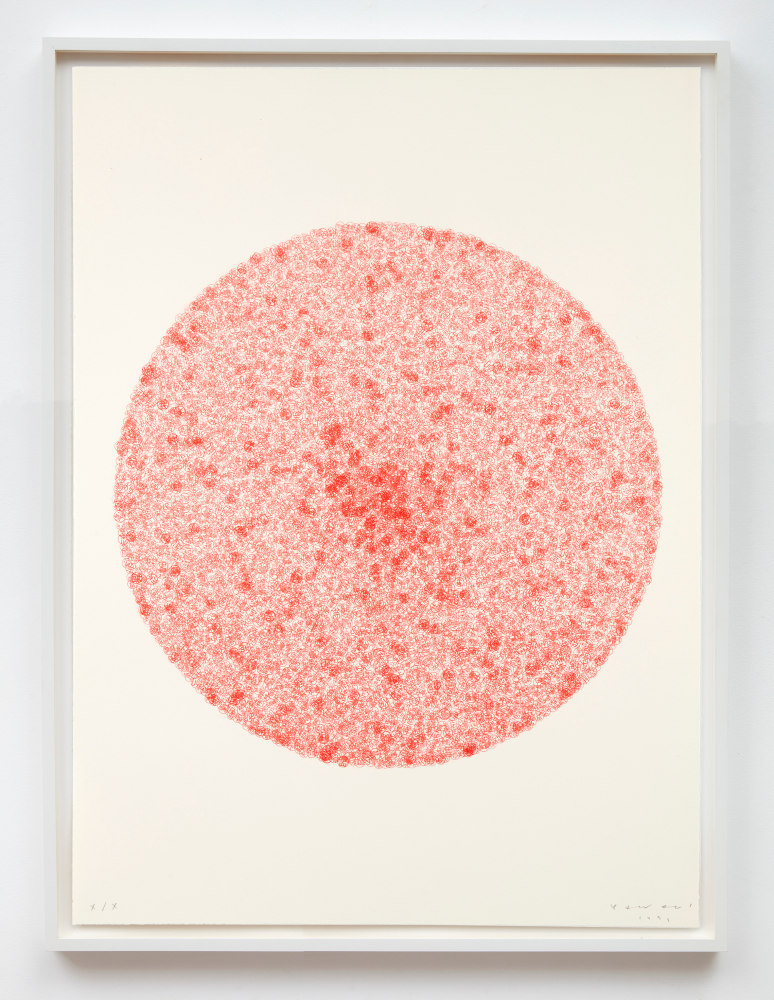
Yukinori Yanagi
Sun from: Hinomaru, 1991
Portfolio of 6 lithographs with embossing and collage on paper
33 x 24 inches (83.8 x 61 cm), each
Edition of 35 + APs
Printed by Maurice Sanchez, New York, NY
Published by Peter Blum Edition
(YY91-45)

Yukinori Yanagi
Eclipse from: Hinomaru, 1991
Portfolio of 6 lithographs with embossing and collage on paper
33 x 24 inches (83.8 x 61 cm), each
Edition of 35 + APs
Printed by Maurice Sanchez, New York, NY
Published by Peter Blum Edition
(YY91-45)
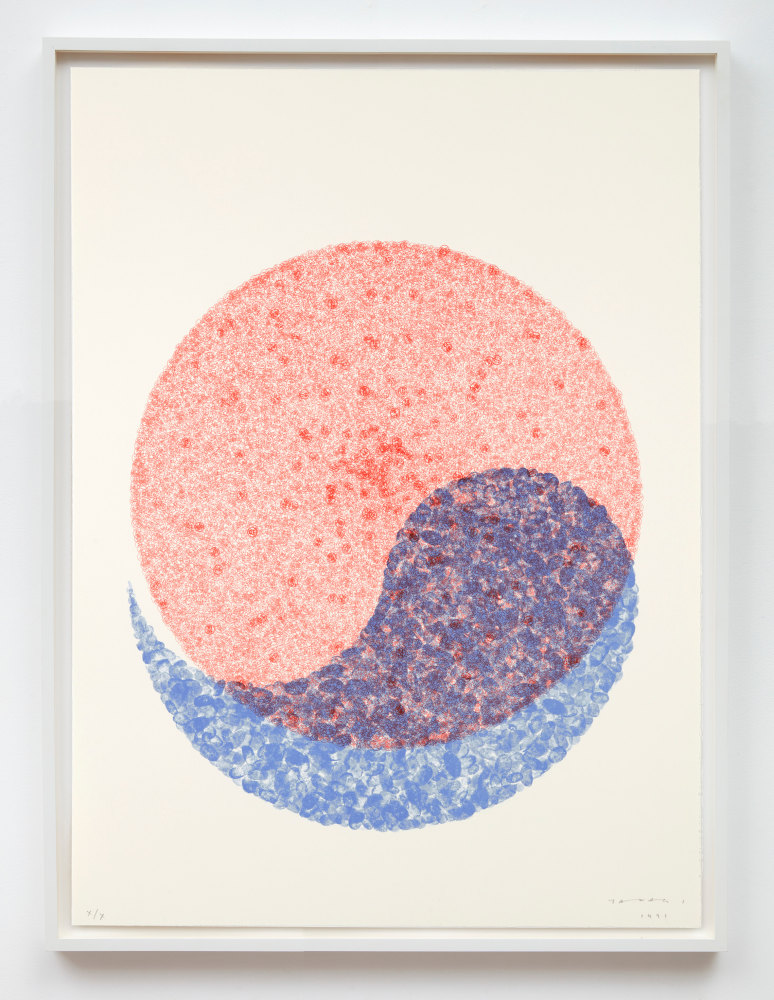
Yukinori Yanagi
Ying/Yang from: Hinomaru, 1991
Portfolio of 6 lithographs with embossing and collage on paper
33 x 24 inches (83.8 x 61 cm), each
Edition of 35 + APs
Printed by Maurice Sanchez, New York, NY
Published by Peter Blum Edition
(YY91-45)

Yukinori Yanagi
Small Sun from: Hinomaru, 1991
Portfolio of 6 lithographs with embossing and collage on paper
33 x 24 inches (83.8 x 61 cm), each
Edition of 35 + APs
Printed by Maurice Sanchez, New York, NY
Published by Peter Blum Edition
(YY91-45)
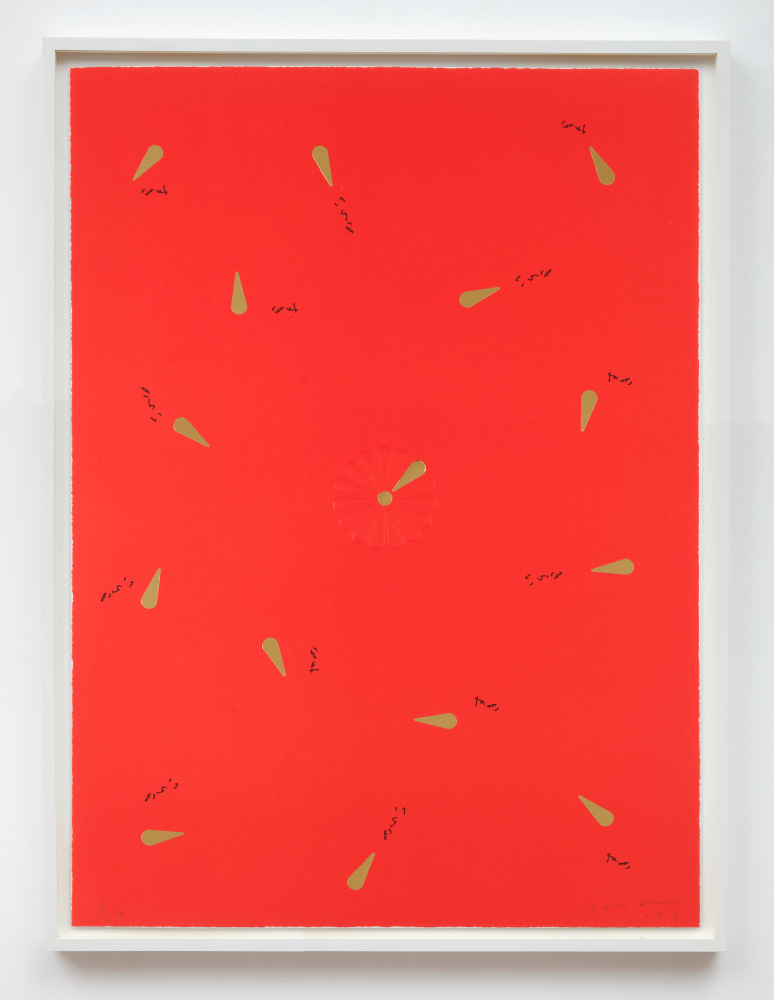
Yukinori Yanagi
Loves me, loves me not from: Hinomaru, 1991
Portfolio of 6 lithographs with embossing and collage on paper
33 x 24 inches (83.8 x 61 cm), each
Edition of 35 + APs
Printed by Maurice Sanchez, New York, NY
Published by Peter Blum Edition
(YY91-45)

Yukinori Yanagi
Hinomaru, 1991
Portfolio of 6 lithographs with embossing and collage on paper
33 x 24 inches (83.8 x 61 cm), each
Edition of 35 + APs
Printed by Maurice Sanchez, New York, NY
Published by Peter Blum Edition
(YY91-45)
“The title of Yukinori Yanagi’s Hinomaru is translated as ‘circle of the sun’ in English; it is the name of the Japanese flag and is more commonly known in English as ‘the rising sun.’ At the time Yanagi made this portfolio, the display of the Hinomaru was a controversial issue in Japan; it was considered by many to be an unacceptable reference to the military aggression, colonialism and fascism of the past. In 1999, a law was passed making the Hinomaru the official flag of Japan, though not without a great deal of resistance on the part of those who find it coercive.
In Yanagi's portfolio, the flag's composition of a red disk against a white ground makes its appearance in the four middle prints. The first and last prints in the portfolio present the chrysanthemum motif, associated with the Japanese royal family; it, too, is a central image in flags, this time representing the emperor and empress, and it is also, significantly for the prints, the image on the Japanese passport. Yanagi makes of the chrysanthemum something both precious and ironic; it is embossed in gold on black in the first print (the actual passport is gold on red); in the last, it is a red-on-red embossment at the center, with individual collaged gold petals strewn and labeled, in Japanese, in phrases that translate as ‘s/he loves me, s/he loves me not.’ The four intervening prints alluding to the Hinomaru present, in sequence: a large single red disk composed of tiny stamps (hanko) used as seals on official documents; a red hanko disk in the process of being eclipsed by a black one; another eclipse of sorts, this time showing a blue half-circle composed of Yanagi’s fingerprints sliding over the bottom of the red disk to imply the formation of the yin-yang motif of the South Korean flag; and another red hanko flag, but smaller this time.
One sees, then, in Yanagi's work of the time a recycling of ideas and motifs to ironic purpose. Yanagi deployed flags as a critique of nationalism, identity was seen as shifting and permeable, and power in all forms was a moving target. Still, Yanagi's treatment of his themes, in the Hinomaru portfolio as in all his installations, is delivered with a light touch. The images in the prints are spare and dry, carrying their heavy emotional freight with ease; there is plenty of bare paper, and the red disks of the Hinomaru flag look as though they have the potential to disintegrate. One feels a liberating ethos at work in the prints, as imagery coalesces, in stamps or fingerprints, as if it could easily drift apart into its molecular parts. Yanagi sought to formally embody a destabilized, ‘wandering position’ (as he was to title his later Blum portfolio), in this way undermining the fixity of nationalism, racial superiority and divine predestination.”
– Faye Hirsch, Content: Prints, Museum of Fine Arts, Houston, 2006
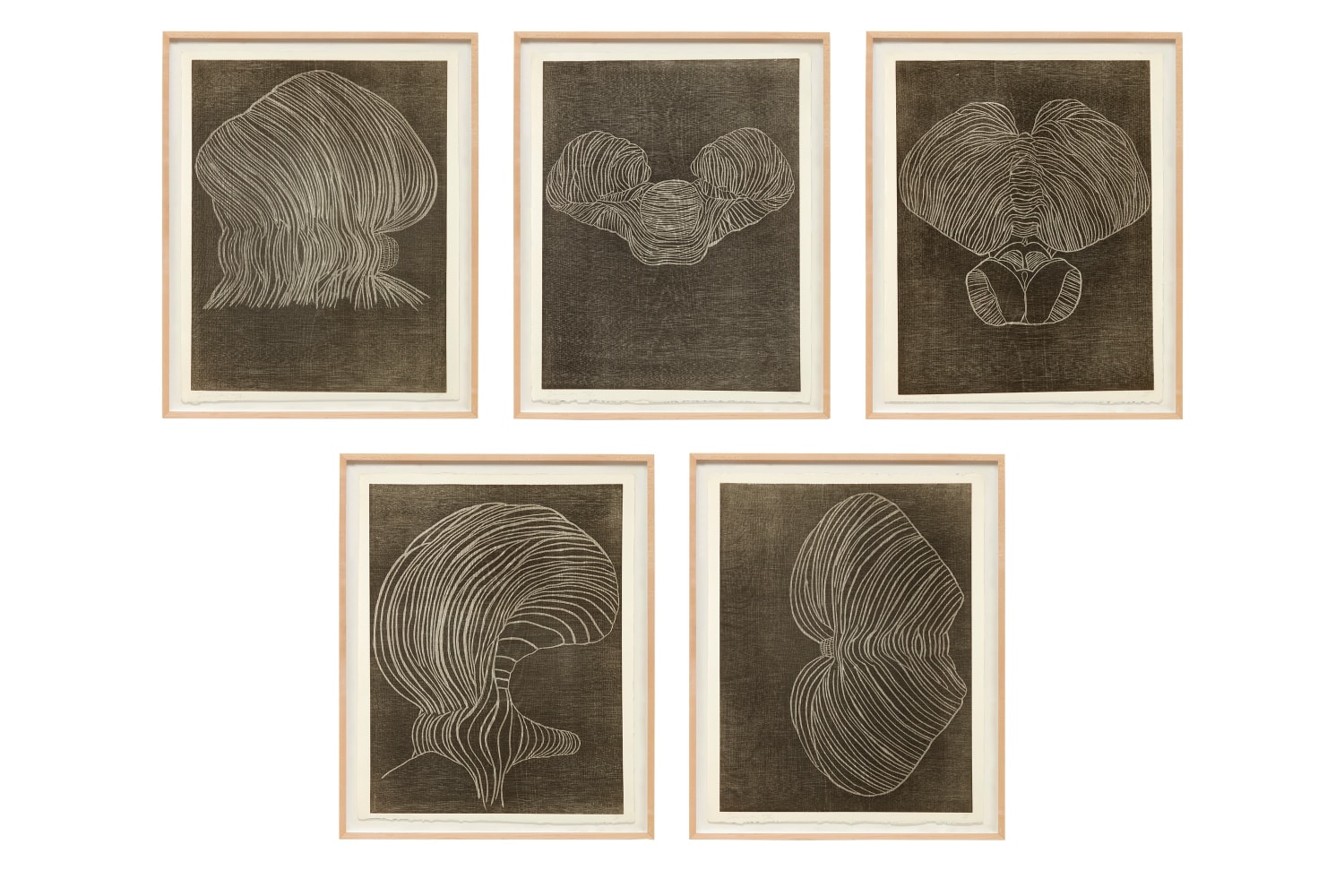
Terry Winters
Furrows, 1989
Portfolio of 5 woodcuts on Cartalafranca paper
27 x 21 1/4 inches (68.6 x 54 cm), each
Edition of 45 + APs
Printed by Francois Lafranca, Verscio, Switzerland
Published by Peter Blum Edition
(TW89-63)
Inquire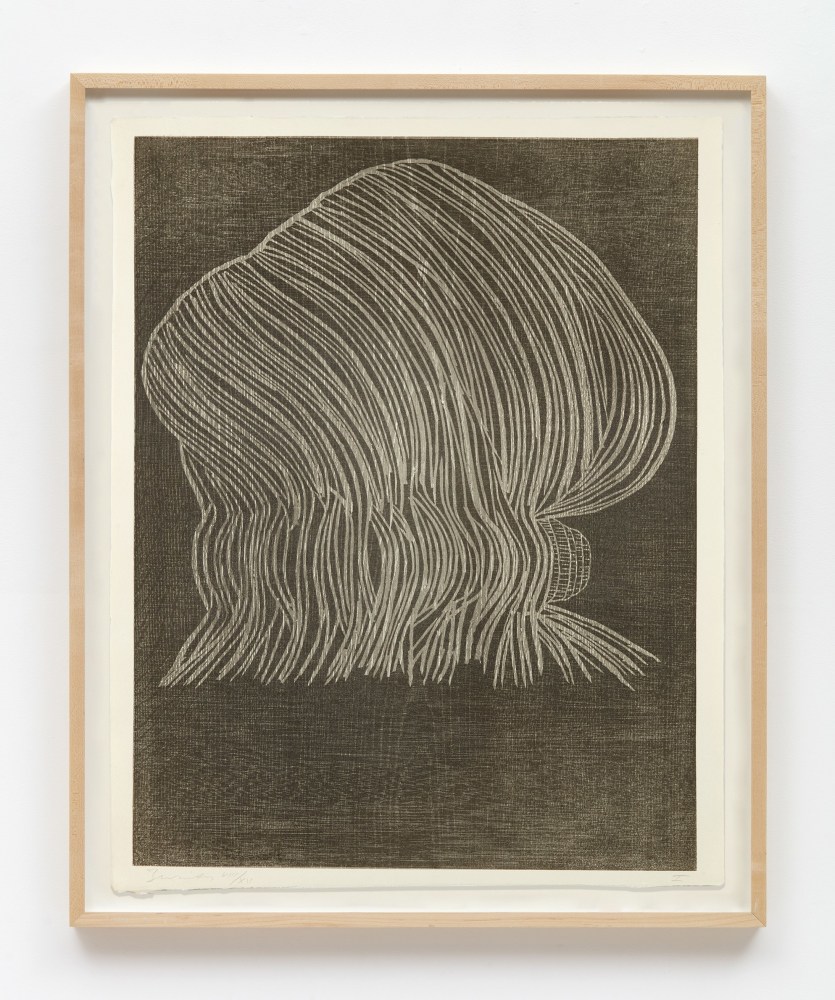
Terry Winters
Furrows, 1989
Portfolio of 5 woodcuts on Cartalafranca paper
27 x 21 1/4 inches (68.6 x 54 cm), each
Edition of 45 + APs
Printed by Francois Lafranca, Verscio, Switzerland
Published by Peter Blum Edition
(TW89-63)
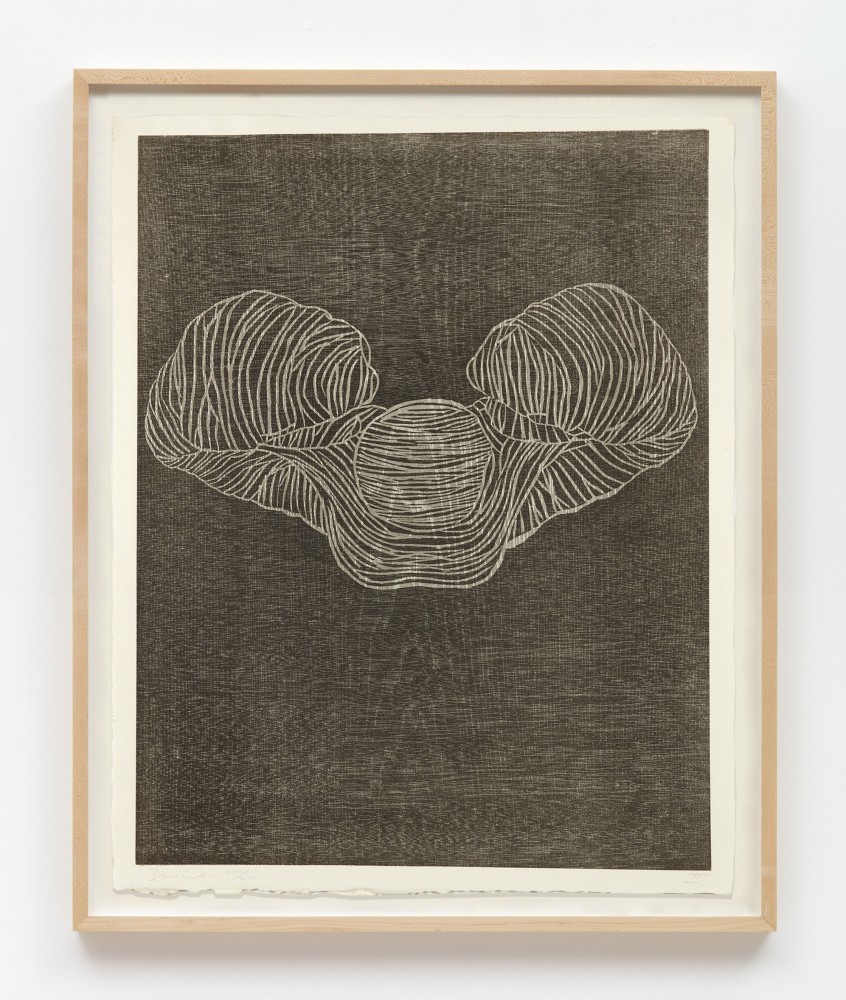
Terry Winters
Furrows, 1989
Portfolio of 5 woodcuts on Cartalafranca paper
27 x 21 1/4 inches (68.6 x 54 cm), each
Edition of 45 + APs
Printed by Francois Lafranca, Verscio, Switzerland
Published by Peter Blum Edition
(TW89-63)

Terry Winters
Furrows, 1989
Portfolio of 5 woodcuts on Cartalafranca paper
27 x 21 1/4 inches (68.6 x 54 cm), each
Edition of 45 + APs
Printed by Francois Lafranca, Verscio, Switzerland
Published by Peter Blum Edition
(TW89-63)
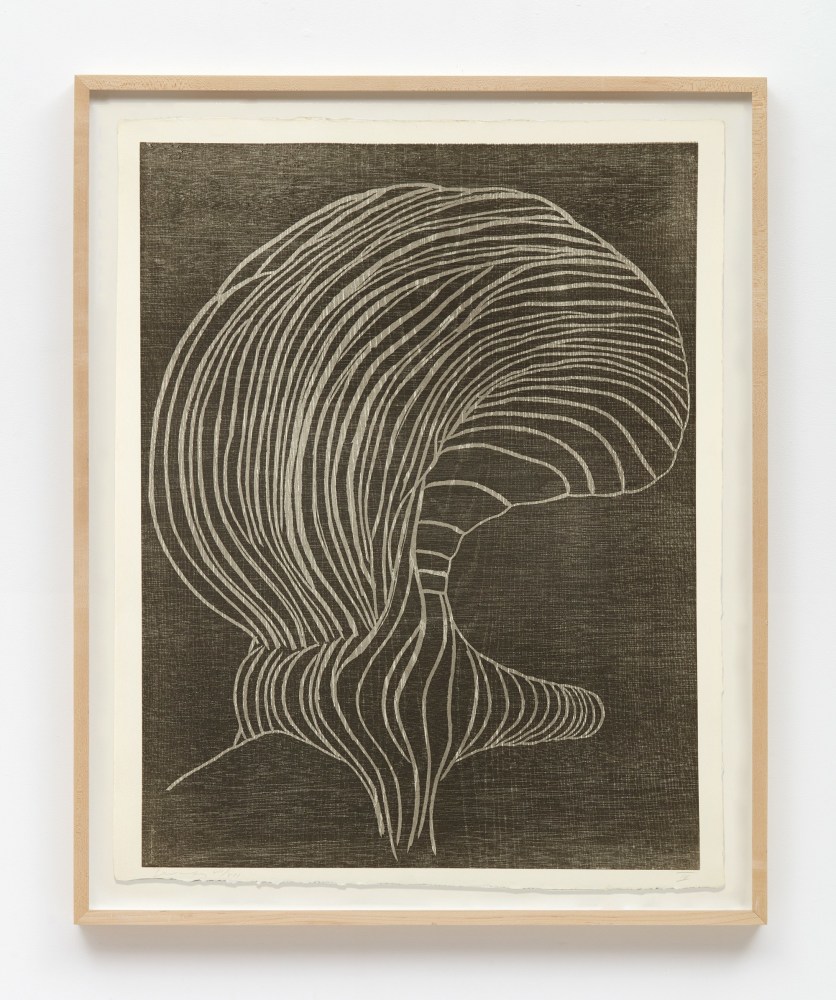
Terry Winters
Furrows, 1989
Portfolio of 5 woodcuts on Cartalafranca paper
27 x 21 1/4 inches (68.6 x 54 cm), each
Edition of 45 + APs
Printed by Francois Lafranca, Verscio, Switzerland
Published by Peter Blum Edition
(TW89-63)

Terry Winters
Furrows, 1989
Portfolio of 5 woodcuts on Cartalafranca paper
27 x 21 1/4 inches (68.6 x 54 cm), each
Edition of 45 + APs
Printed by Francois Lafranca, Verscio, Switzerland
Published by Peter Blum Edition
(TW89-63)
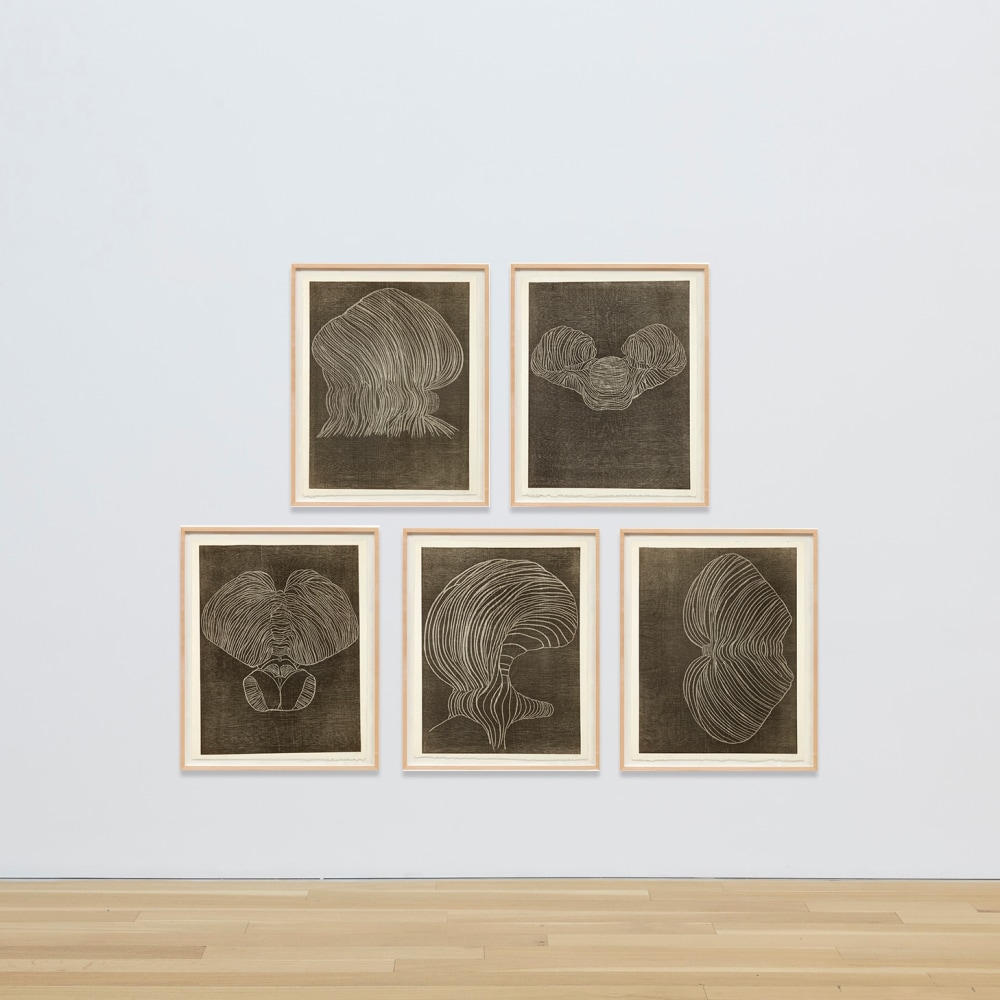
Terry Winters
Furrows, 1989
Portfolio of 5 woodcuts on Cartalafranca paper
27 x 21 1/4 inches (68.6 x 54 cm), each
Edition of 45 + APs
Printed by Francois Lafranca, Verscio, Switzerland
Published by Peter Blum Edition
(TW89-63)

Terry Winters
Furrows, 1989
Portfolio of 5 woodcuts on Cartalafranca paper
27 x 21 1/4 inches (68.6 x 54 cm), each
Edition of 45 + APs
Printed by Francois Lafranca, Verscio, Switzerland
Published by Peter Blum Edition
(TW89-63)
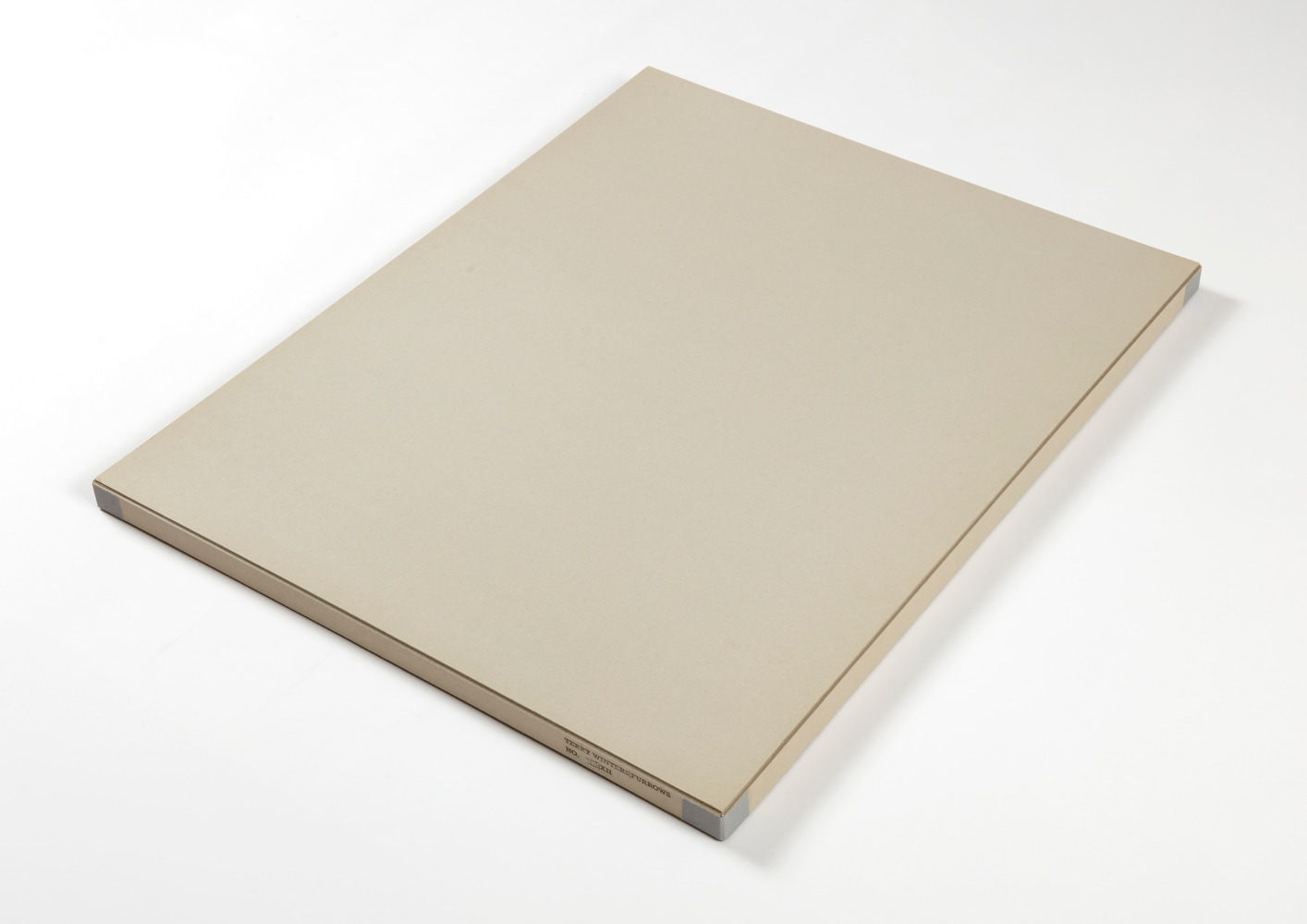
Terry Winters
Furrows, 1989
Portfolio of 5 woodcuts on Cartalafranca paper
27 x 21 1/4 inches (68.6 x 54 cm), each
Edition of 45 + APs
Printed by Francois Lafranca, Verscio, Switzerland
Published by Peter Blum Edition
(TW89-63)
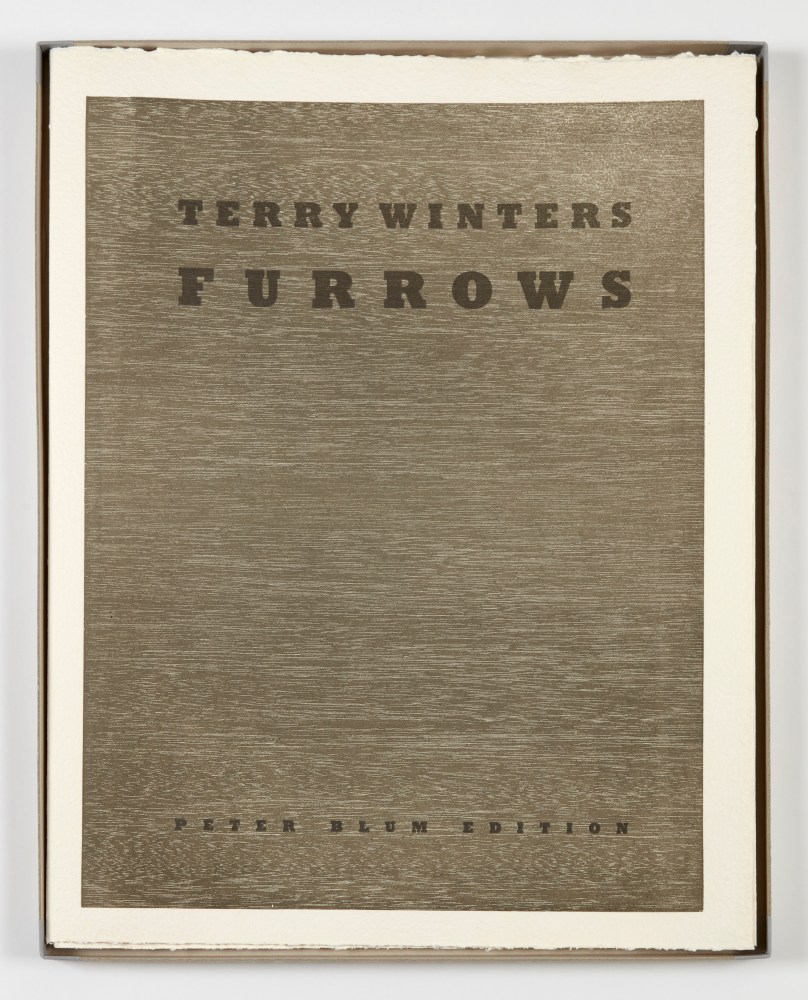
Terry Winters
Furrows, 1989
Portfolio of 5 woodcuts on Cartalafranca paper
27 x 21 1/4 inches (68.6 x 54 cm), each
Edition of 45 + APs
Printed by Francois Lafranca, Verscio, Switzerland
Published by Peter Blum Edition
(TW89-63)

Terry Winters
Furrows, 1989
Portfolio of 5 woodcuts on Cartalafranca paper
27 x 21 1/4 inches (68.6 x 54 cm), each
Edition of 45 + APs
Printed by Francois Lafranca, Verscio, Switzerland
Published by Peter Blum Edition
(TW89-63)
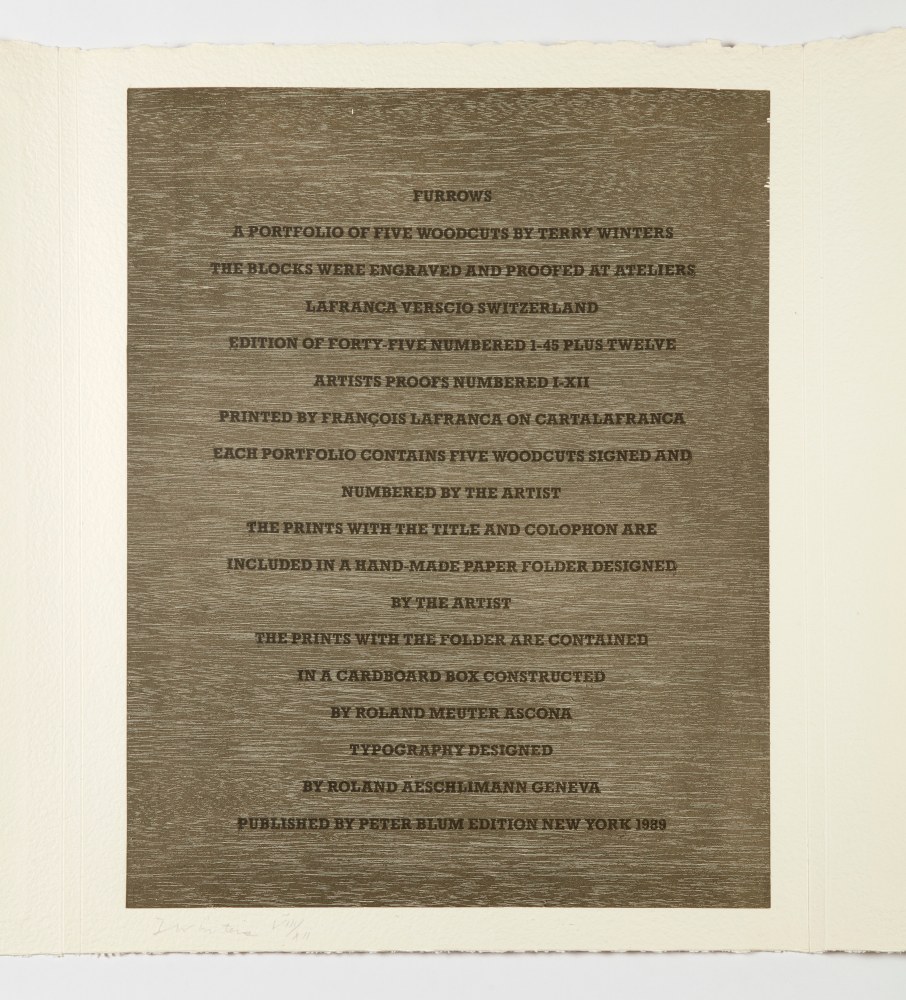
Terry Winters
Furrows, 1989
Portfolio of 5 woodcuts on Cartalafranca paper
27 x 21 1/4 inches (68.6 x 54 cm), each
Edition of 45 + APs
Printed by Francois Lafranca, Verscio, Switzerland
Published by Peter Blum Edition
(TW89-63)
“The images in Terry Winters’s Furrows evolved from drawings Winters brought to Switzerland from New York. His Japanese tools gave him the idea of making a linear print, but he was also inspired by the Zen gardens in Kyoto-for example, the Sea of Silver Sand at Ginkaku-ji, where gravel is raked into perfect lines. The Kyoto gardens 'knocked me out,' Winters recounts, 'the combination of the invention of natural forms within a designed context. It was incredible to me the way in which it contained and amplified what was most interesting to me about natural structures.' For Winters, there is always a synergy between the geometric and the organic, the man-made and the natural. The resulting motifs, derived from nervous systems and brain structures, also referred to the rocks and stones of the Kyoto gardens. But they deviate from their sources to become something entirely different.
At times, the prints look as though they might be a single image seen from different angles a reading reinforced by the consistency of Winters's approach in building each image and the repeated striations-but close inspection reveals that each form is independent. Some of the images suggest fantastic insects, sea urchins or plants; others imply the human form viewed from surprising angles. Each has multiple readings, enigmatic but mutually informing. As Winters remarks, 'There is some way that the combination of all the prints together gives a sense of what the subject is without it having to be carried by one sheet.' Like Brice Marden, Winters has exploited the narrative potential of the portfolio format.
The linearity of the prints is far ahead of the drawings Winters was making at the time and begins to anticipate the strategic break he would make shortly when he abandoned motifs drawn from nature. As in the case of his collaboration with Marden, Peter Blum had elected to work with Winters at a moment of breakthrough and change. Winters best exemplifies Salle's contention that there was a need to reinvest formalism with content. Whereas Salle's solution was a method of appropriation that in retrospect seems all surface, Winters sought to investigate activity beneath the surface of life, of paint, of the human organism. A strong sense of metaphor pervades his work of the 1980s, but its meaning remains enigmatic.”
– Jeremy Lewison, The Quest for Content, Museum of Fine Arts, Houston, 2006
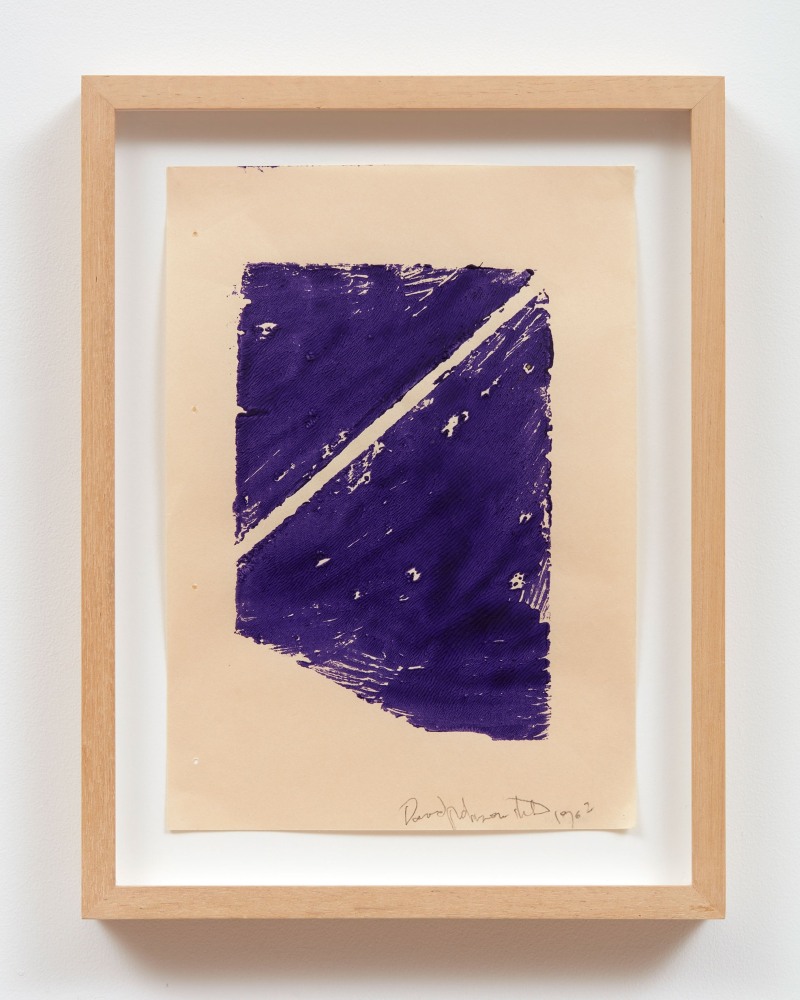
David Rabinowitch
Untitled, 1962
Woodblock monotype on paper
10 1/8 x 7 1/8 inches (25.7 x 18.1 cm)
Unique
(DR62-104)
Inquire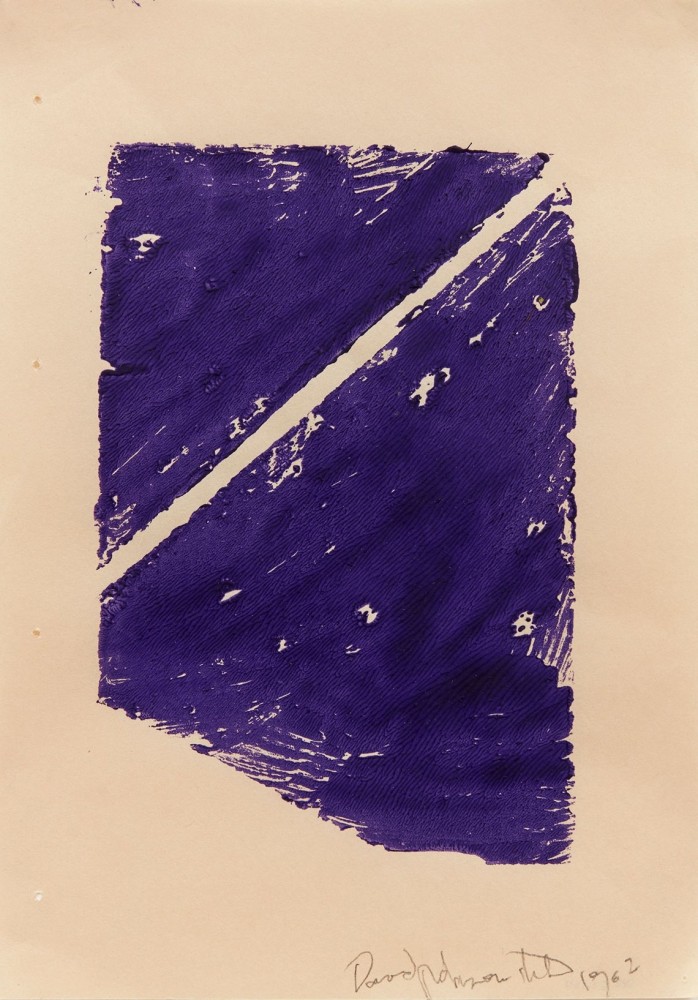
David Rabinowitch
Untitled, 1962
Woodblock monotype on paper
10 1/8 x 7 1/8 inches (25.7 x 18.1 cm)
Unique
(DR62-104)
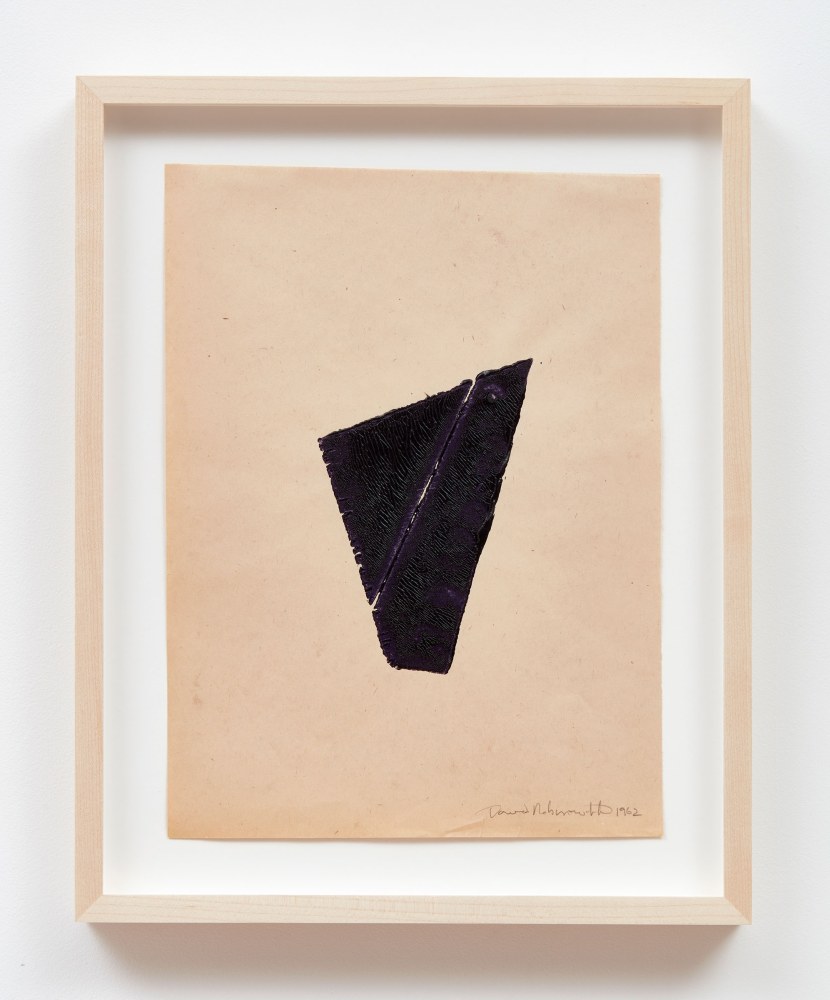
David Rabinowitch
Untitled, 1962
Woodblock monotype on paper
12 1/4 x 9 inches (31.1 x 22.9 cm)
Unique
(DR62-161)
Inquire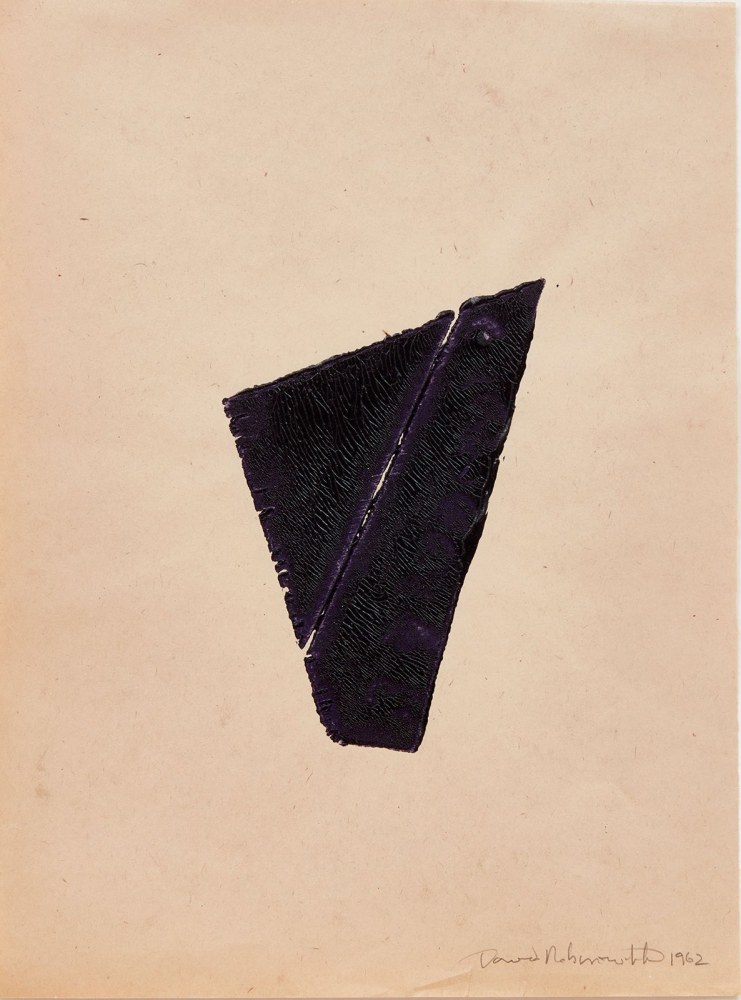
David Rabinowitch
Untitled, 1962
Woodblock monotype on paper
12 1/4 x 9 inches (31.1 x 22.9 cm)
Unique
(DR62-161)
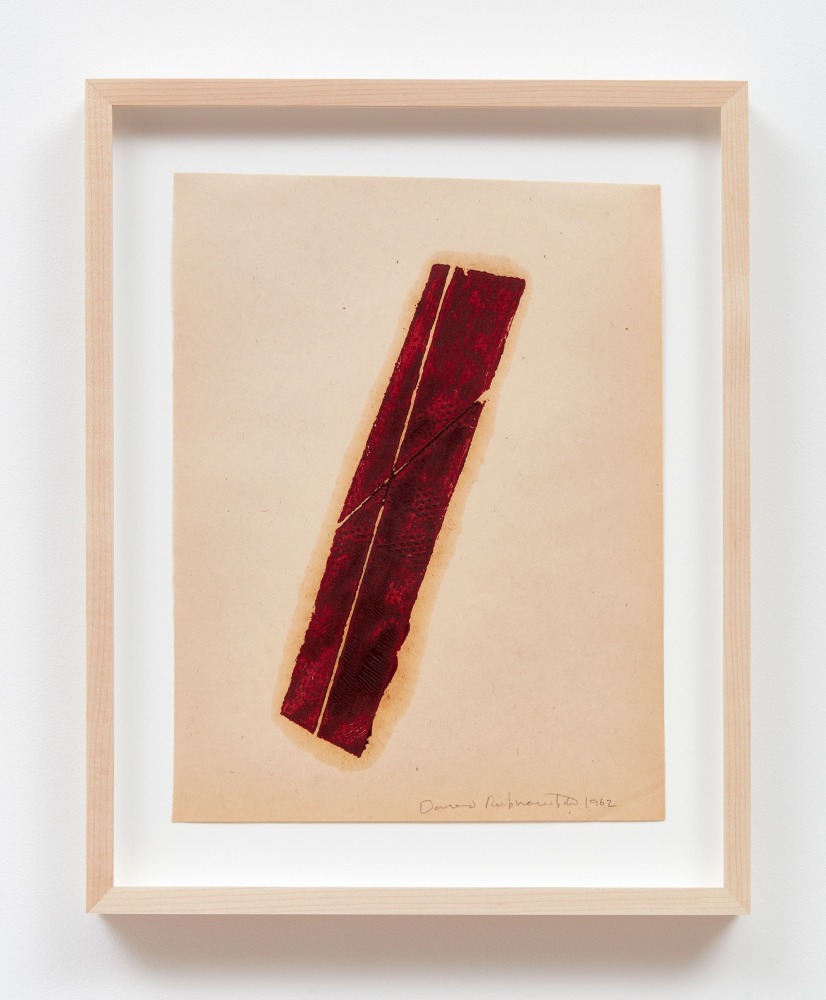
David Rabinowitch
Untitled, 1962
Woodblock monotype on paper
11 3/4 x 9 1/8 inches (29.8 x 23.2 cm)
Unique
(DR62-163)
Inquire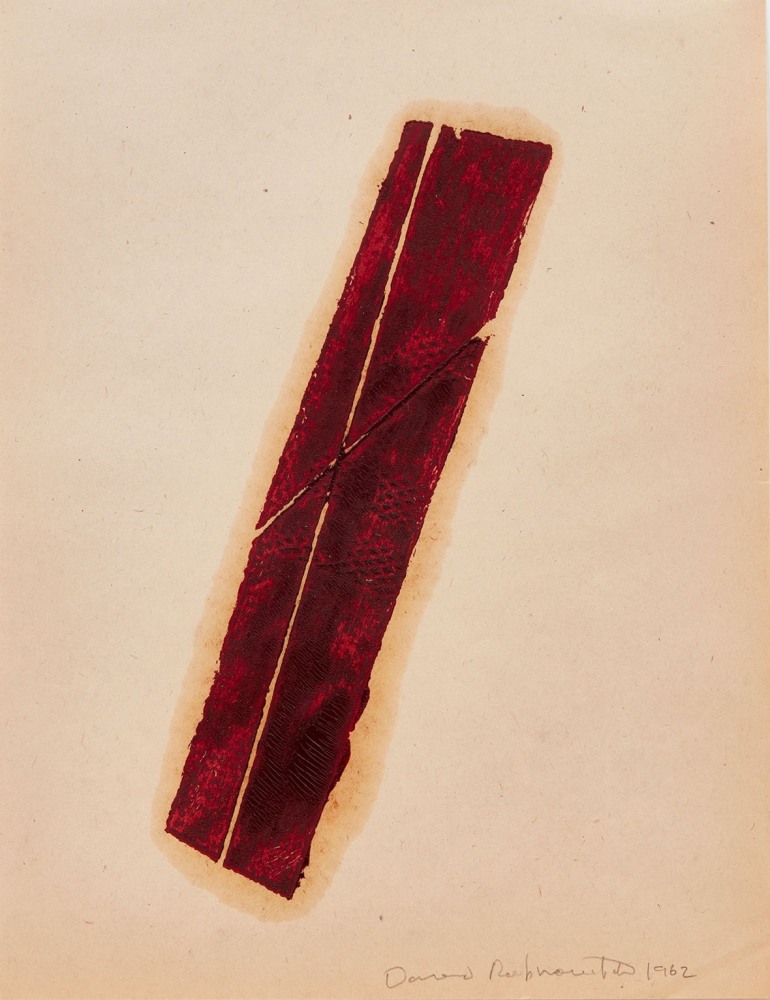
David Rabinowitch
Untitled, 1962
Woodblock monotype on paper
11 3/4 x 9 1/8 inches (29.8 x 23.2 cm)
Unique
(DR62-163)
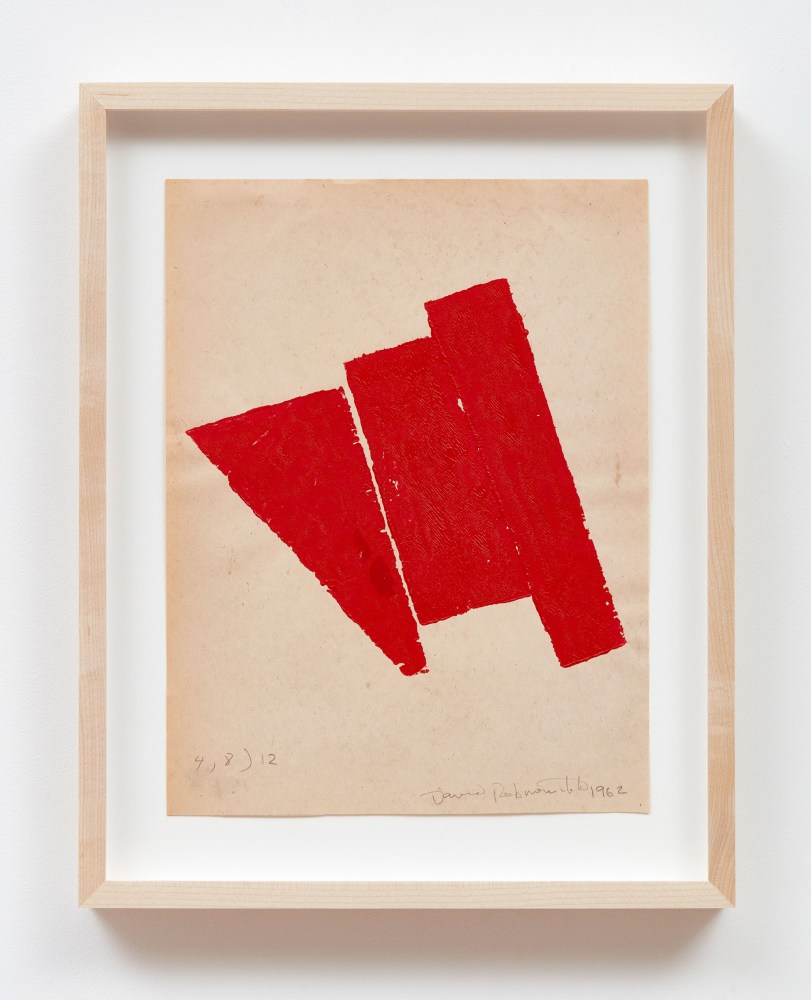
David Rabinowitch
Untitled, 1962
Woodblock monotype on paper
11 7/8 x 9 inches (30.16 x 22.86 cm)
Unique
(DR62-169)
Inquire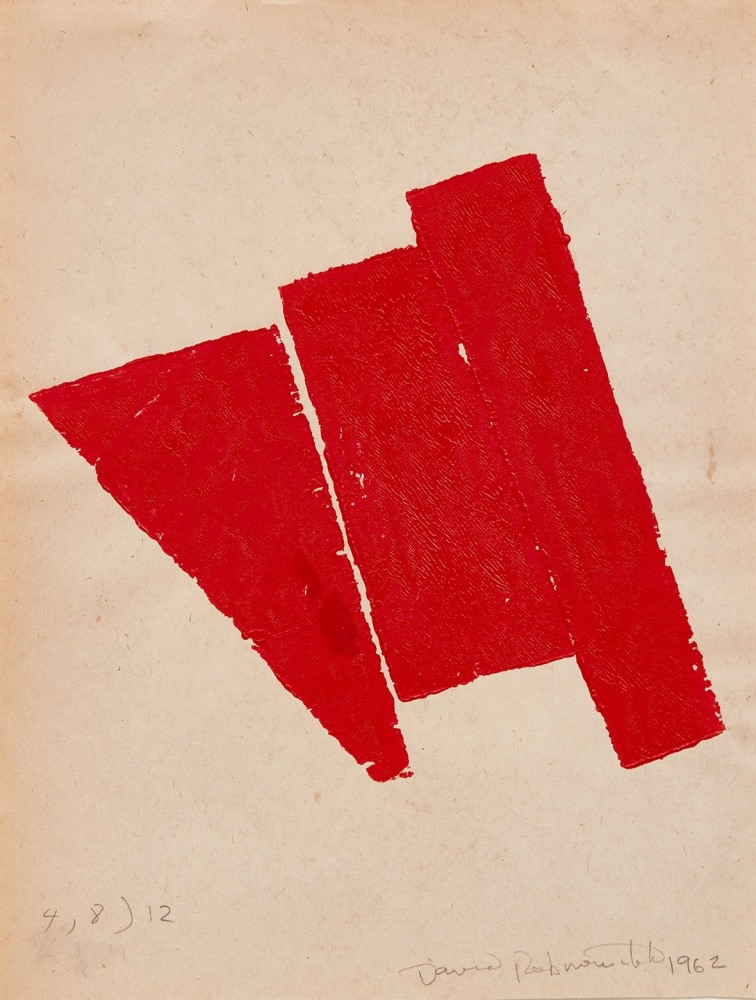
David Rabinowitch
Untitled, 1962
Woodblock monotype on paper
11 7/8 x 9 inches (30.16 x 22.86 cm)
Unique
(DR62-169)
“David Rabinowitch's carved woodblock monotypes from 1962, recently rediscovered by him in the suburban Toronto house where he grew up, appear to anticipate sculptures he made years afterwards. Even if only hindsight produces this impression, we ought to take it seriously, because Rabinowitch's art has always concerned itself with the distances and directions from which things are seen. The monotypes shift those concerns into a temporal key. They lead us to wonder how far promptings to interpretation, or reinterpretation, echo backward and forward, as we consider Rabinowitch's development as an artist.
The monotypes date from a moment when Rabinowitch's ambitions veered from painting into sculpture. (He was 19 at the time.) Many of the emblematic shapes in the woodblock prints seem clearly to rehearse the plan views of sculptures from series begun in the late 60s, known as Sided Masses and Romanesque Abutments. The blocky irregularity of a steel floor piece such as Sided Mass (with Straight and Free Sides) II, 1968, might easily be confused in memory with those in some of the simpler monotypes. In both media, Rabinowitch typically avoided symmetry, easily nameable shapes and obvious priorities of orientation, titles and signatures on some of the prints notwithstanding. The inscriptions look today like touching symptoms of anxiety about making 'a name' as an artist.
The colored forms in the monotypes plot the margins of abstraction. Viewed as a sequence, the prints seem to track a process of parrying and fending off easy recognition. Here and there Rabinowitch tries to own the game by appending a title, such as Hebrew Letter. But even without any such clue, the viewer would quickly come to see the monotypes as probing for an abstract ideography - signs that inscribe nothing beyond themselves, besides their distinctness from one another and a sense of unexploited semiotic availability. The viewer's eye, as the artist's own must have done, restlessly checks the series for repetitions, rotations, permutations of colors or shape and other possible variants. When none appears, the sequence takes on the character of a cognitive exercise: to learn a preference for figures that are not consumed in being seen, but encourage persistent attention, and even become emblematic of it.
In retrospect, the monotypes hint that they might be unconscious communications to a consciousness - the artist's own, and ours - not yet prepared to decipher them. I would argue that we see their wordless decipherment in the sculptures foreshadowed in the prints.
– Kenneth Baker, David Rabinowitch: Carved Woodblock Monotypes 1962, 2003
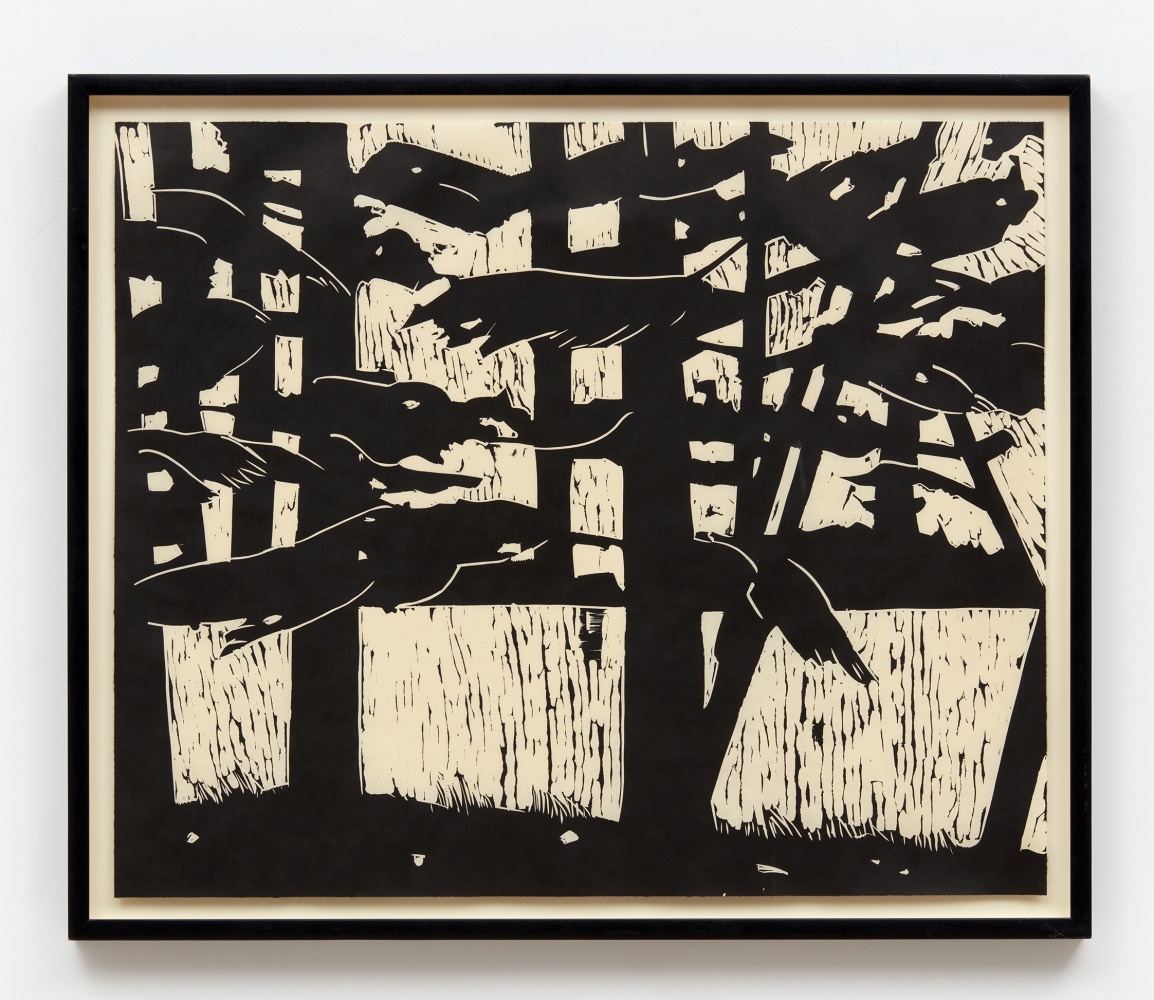
Alex Katz
Pines, 2003
Linocut on Okawara paper 27 5/8 x 33 1/4 inches (70.2 x 84.5 cm)
Edition of 30 + APs
Printed by Chris Erickson, Brooklyn, NY
Published by Peter Blum Edition
(AK03-45)
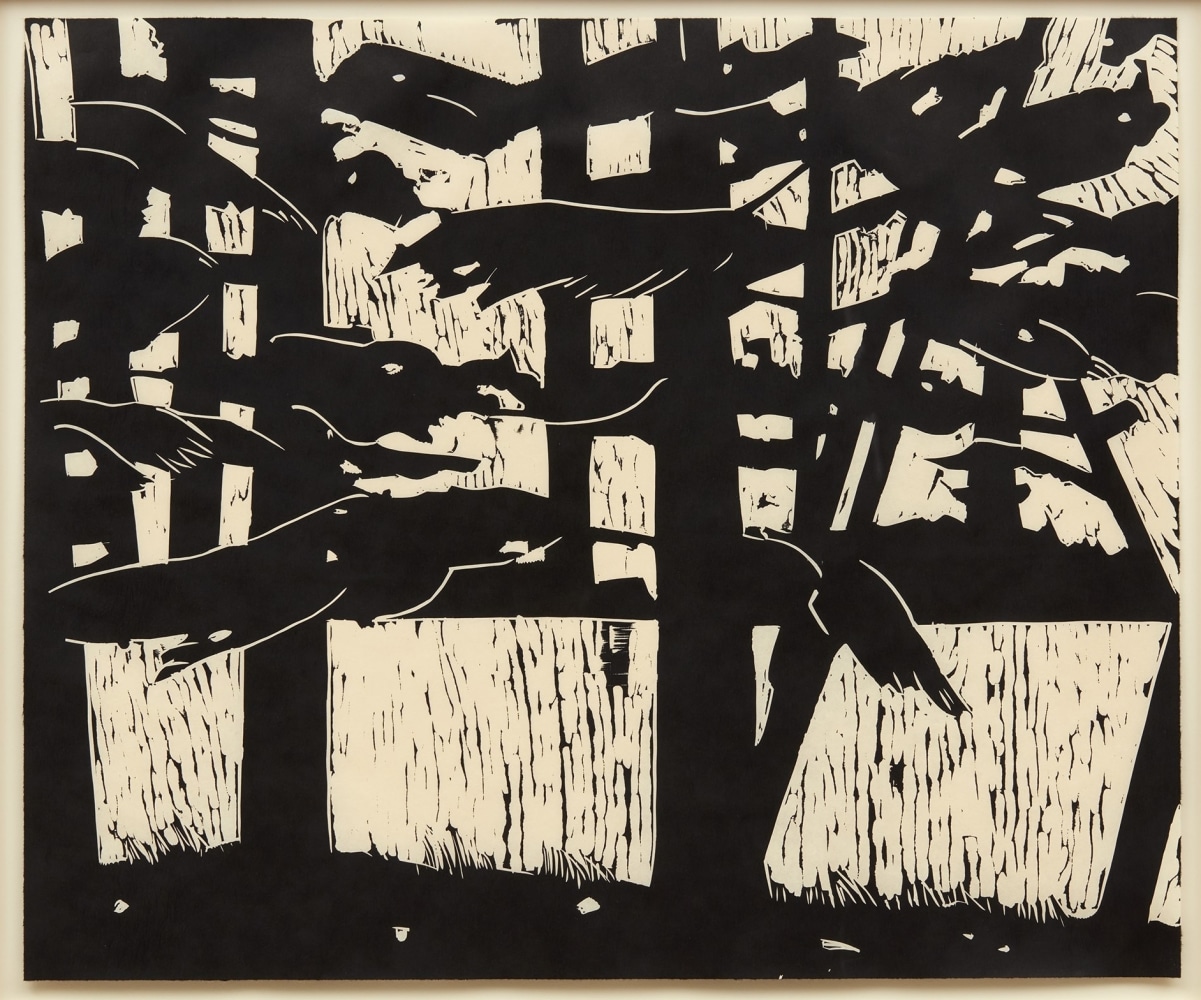
Alex Katz
Pines, 2003
Linocut on Okawara paper 27 5/8 x 33 1/4 inches (70.2 x 84.5 cm)
Edition of 30 + APs
Printed by Chris Erickson, Brooklyn, NY
Published by Peter Blum Edition
(AK03-45)

Alex Katz
Reflection I, 2010
Aquatint on Somerset White paper 18 1/2 x 13 1/2 inches (47 x 34.3 cm)
Edition of 45 + APs Printed by Chris Creyts, New York
Published by Peter Blum Edition
(AK10-05)
Inquire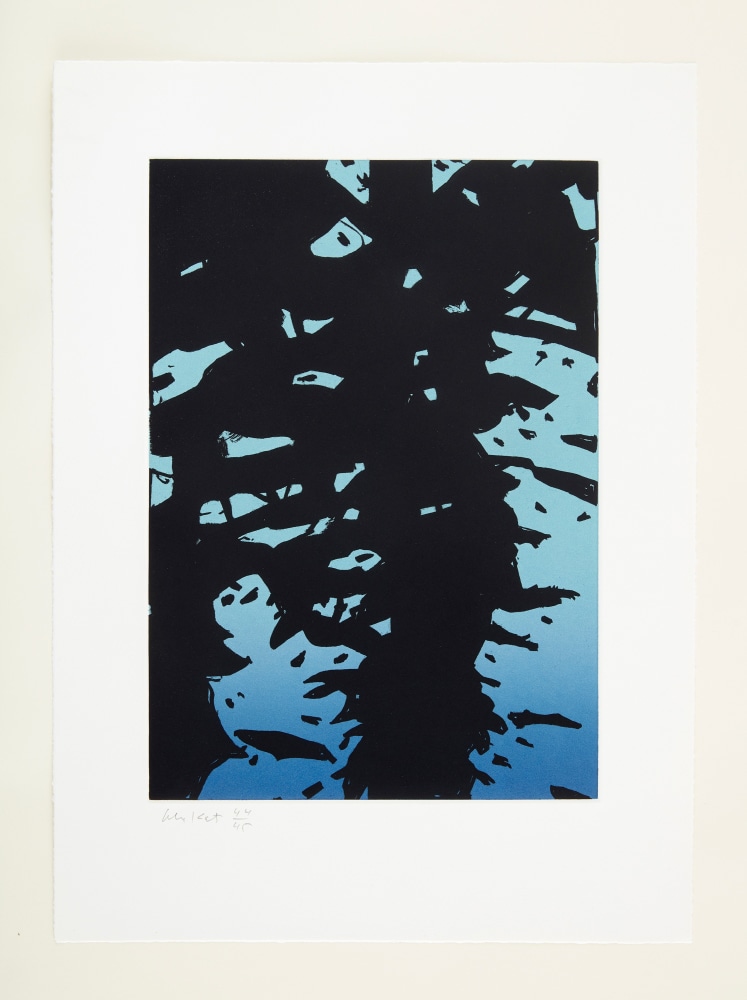
Alex Katz
Reflection I, 2010
Aquatint on Somerset White paper 18 1/2 x 13 1/2 inches (47 x 34.3 cm)
Edition of 45 + APs
Printed by Chris Creyts, New York
Published by Peter Blum Edition
(AK10-05)
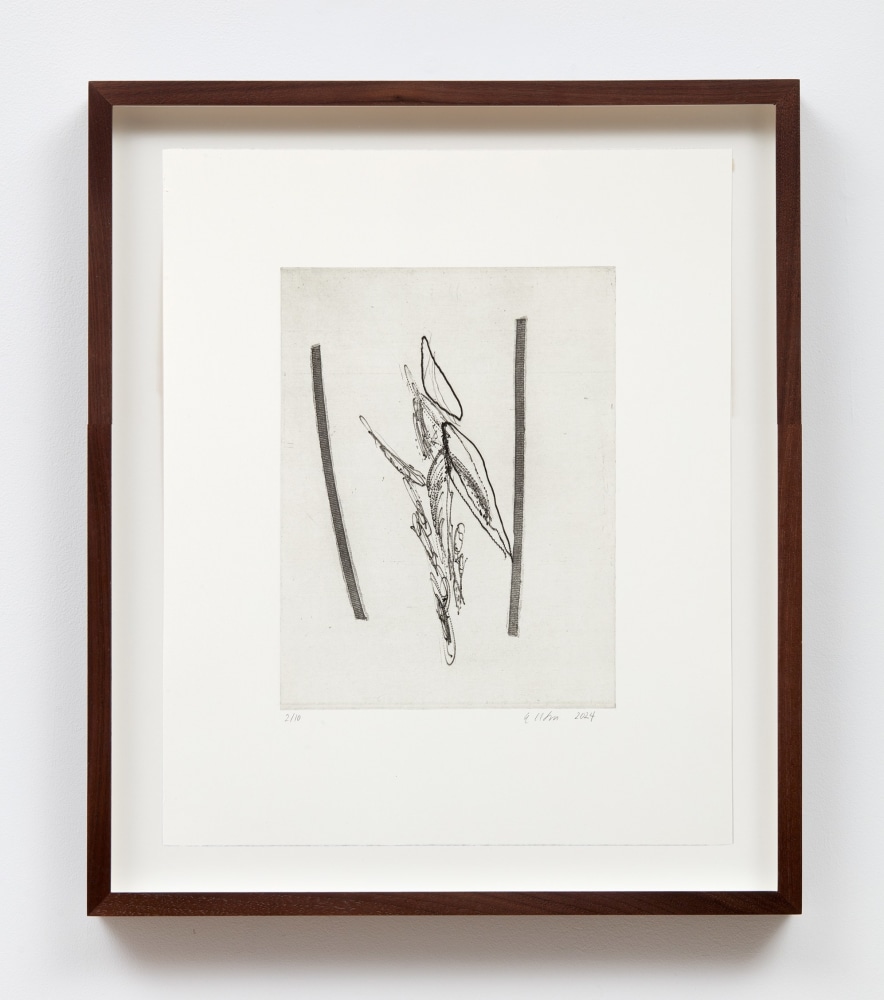
Erik Lindman
Helian Etching I, 2024
Drypoint and soft ground etching on Hahnemühle Copperplate paper
18 1/2 x 15 inches (47 x 38.1 cm)
Edition of 10
Printed by Johanna Velasquez, New York, NY
(EL24-05.2)
Inquire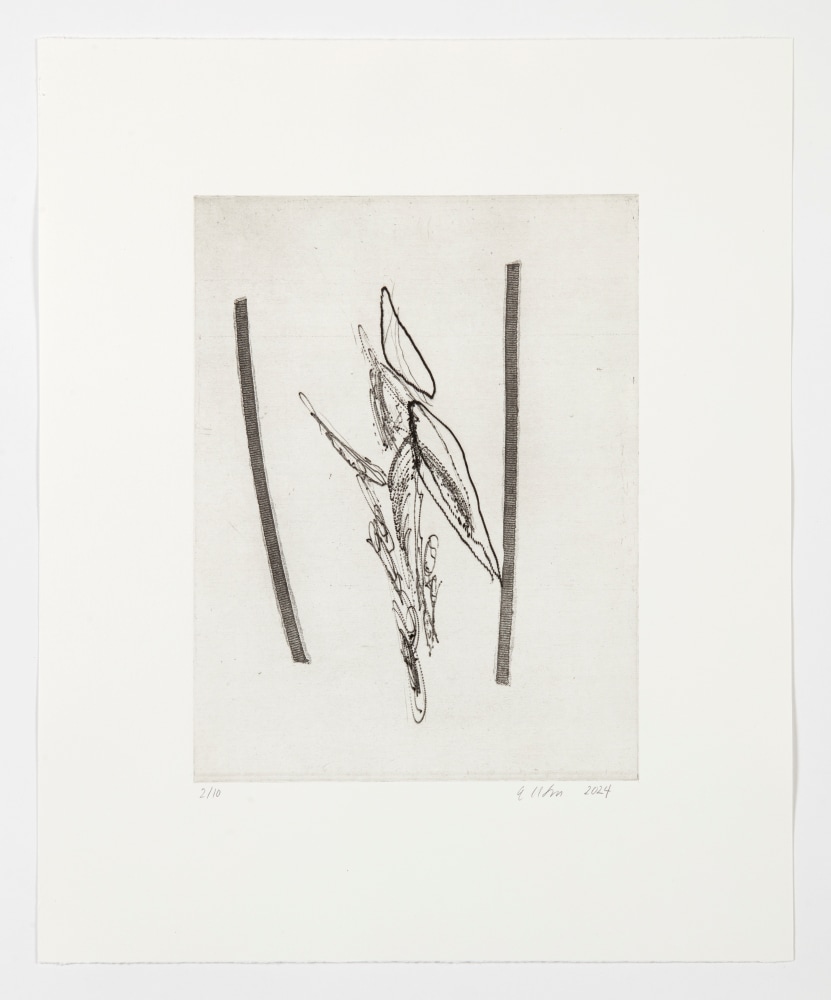
Erik Lindman
Helian Etching I, 2024
Drypoint and soft ground etching on Hahnemühle Copperplate paper
18 1/2 x 15 inches (47 x 38.1 cm)
Edition of 10
Printed by Johanna Velasquez, New York, NY
(EL24-05.2)
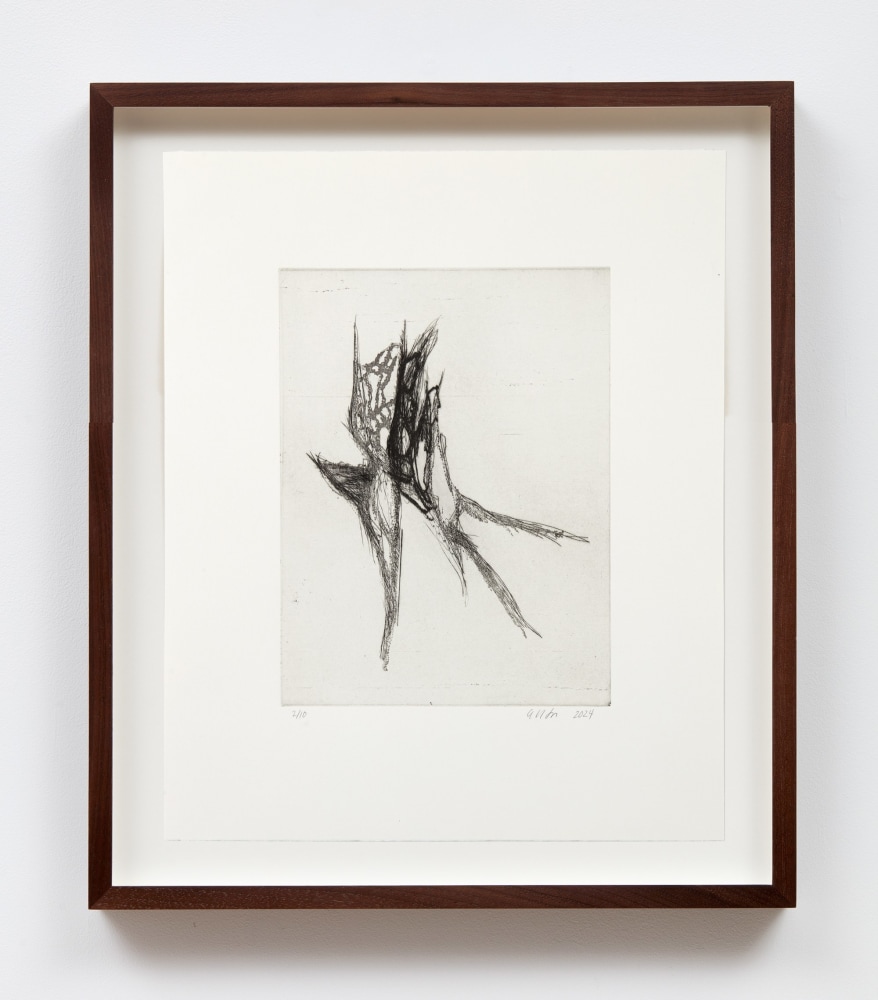
Erik Lindman
Helian Etching II, 2024
Drypoint and soft ground etching on Hahnemühle Copperplate paper
18 1/2 x 15 inches (47 x 38.1 cm)
Edition of 10
Printed by Johanna Velasquez, New York, NY
(EL24-06.2)
Inquire
Erik Lindman
Helian Etching II, 2024
Drypoint and soft ground etching on Hahnemühle Copperplate paper
18 1/2 x 15 inches (47 x 38.1 cm)
Edition of 10
Printed by Johanna Velasquez, New York, NY
(EL24-06.2)
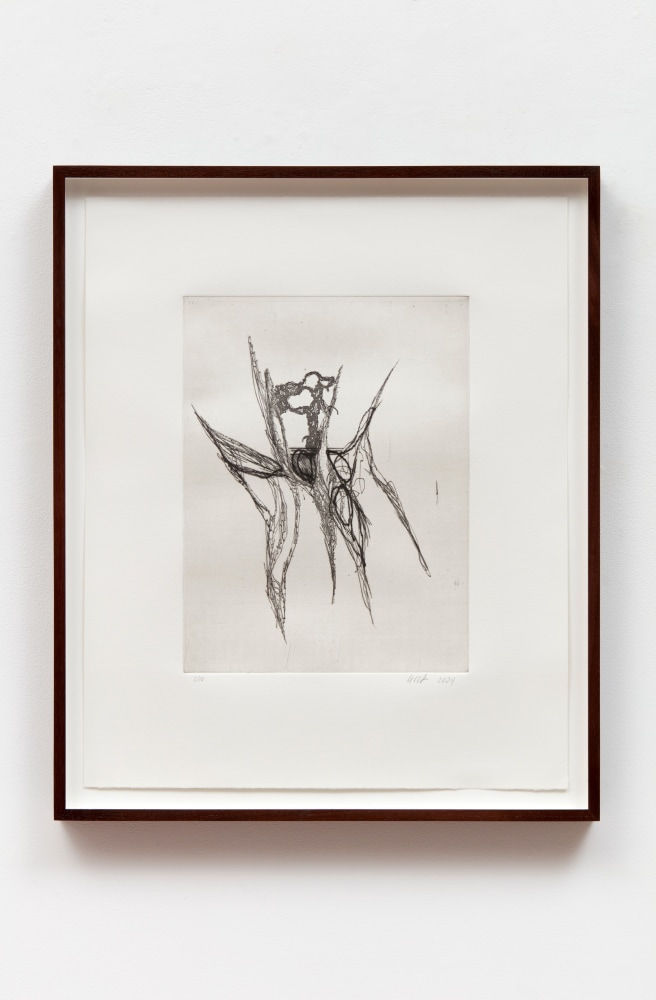
Erik Lindman
Helian Etching III, 2024
Drypoint and soft ground etching on Hahnemühle Copperplate paper
18 1/2 x 15 inches (47 x 38.1 cm)
Edition of 10
Printed by Johanna Velasquez, New York, NY
(EL24-07.2)
Inquire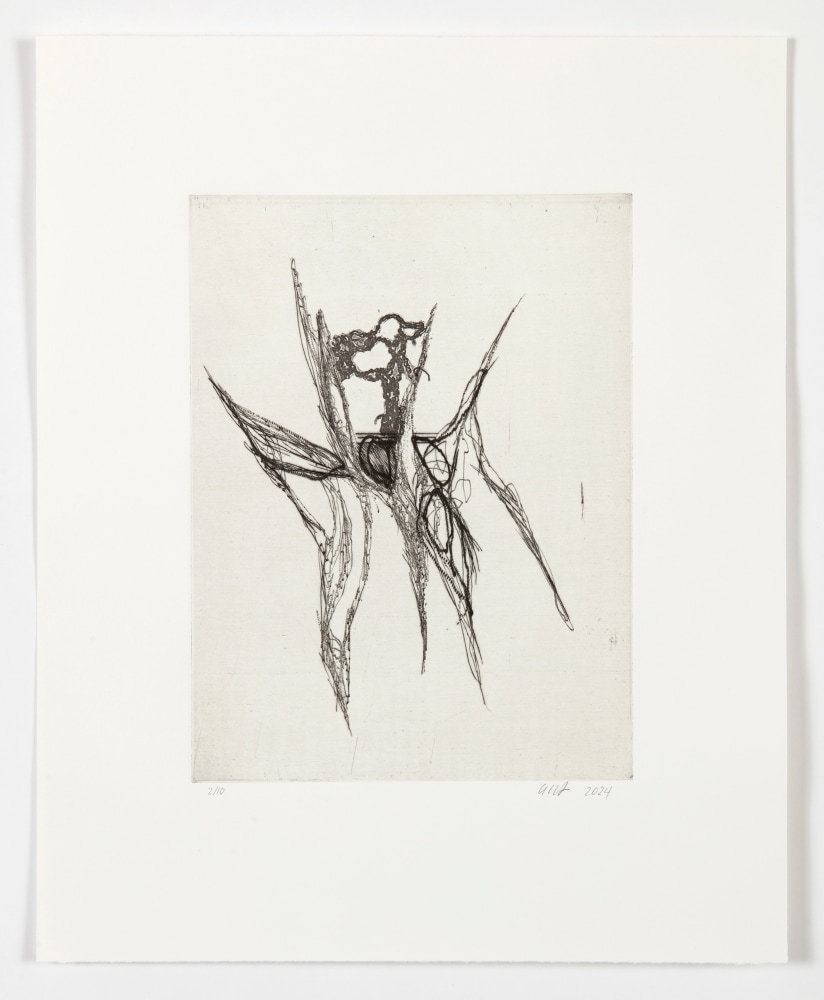
Erik Lindman
Helian Etching III, 2024
Drypoint and soft ground etching on Hahnemühle Copperplate paper
18 1/2 x 15 inches (47 x 38.1 cm)
Edition of 10
Printed by Johanna Velasquez, New York, NY
(EL24-07.2)
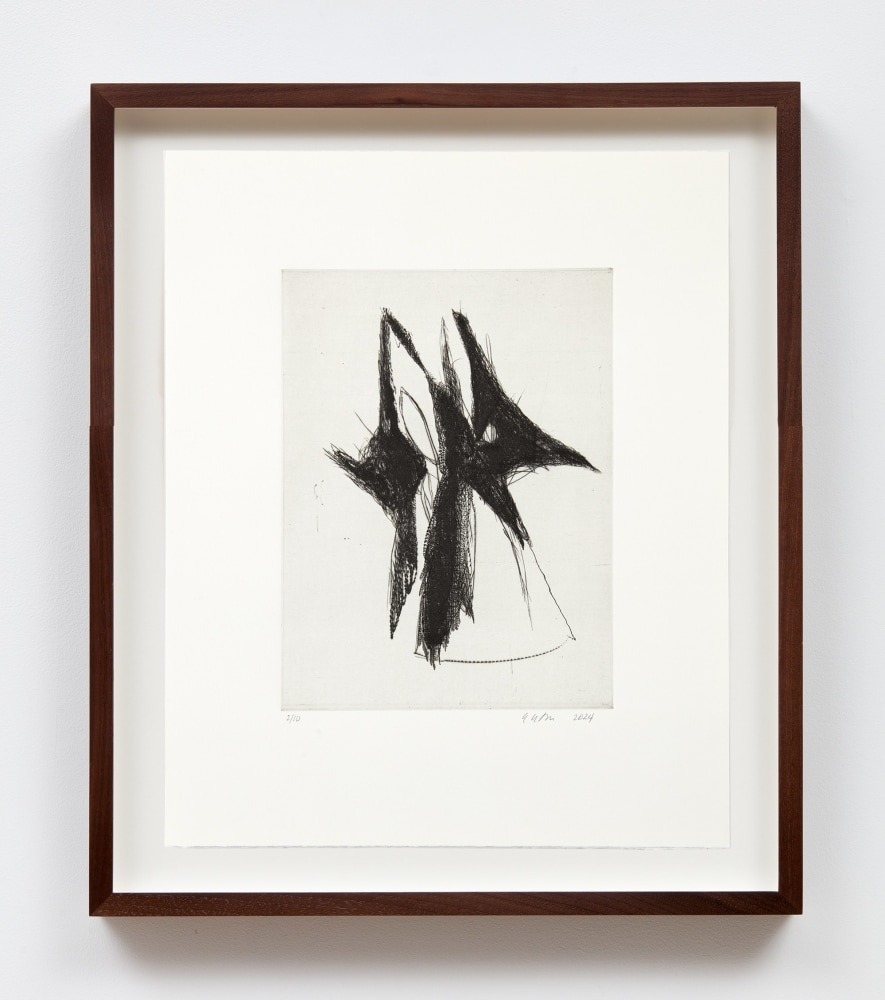
Erik Lindman
Helian Etching IV, 2024
Drypoint on Hahnemühle Copperplate paper
18 1/2 x 15 inches (47 x 38.1 cm)
Edition of 10
Printed by Johanna Velasquez, New York, NY
(EL24-08.2)
Inquire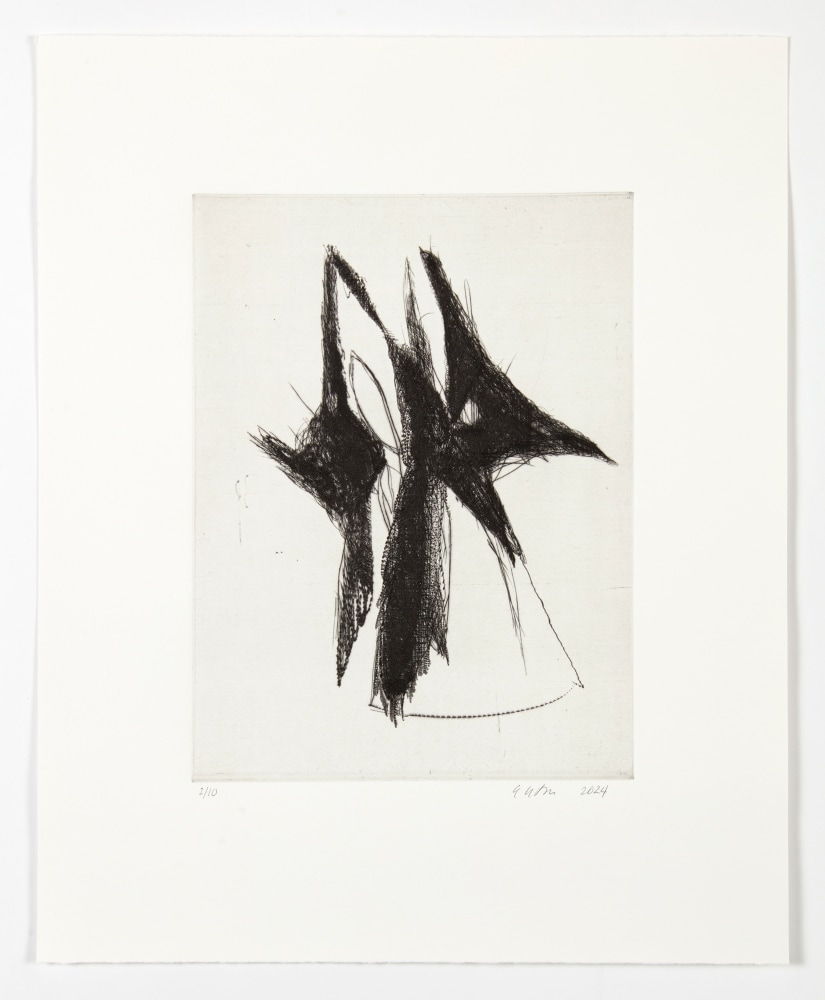
Erik Lindman
Helian Etching IV, 2024
Drypoint on Hahnemühle Copperplate paper
18 1/2 x 15 inches (47 x 38.1 cm)
Edition of 10
Printed by Johanna Velasquez, New York, NY
(EL24-08.2)
“Since the beginning of my art practice, I have been drawn to the realia of the world, integrating found surfaces and objects into my own personal vocabulary. With my investigation firmly rooted in painting and its history, I have continually made it new, paradoxically testing painting’s boundaries through the exploration of dimensional sculpture and gossamer linear drawings.
To my mind, etchings are squarely at home within this constellation. I approach the copperplate directly as an object, gouging its surface with a mechanical rotary tool [Dremel] and scratching it with a traditional diamond-tipped stylus. The resulting lines feel physical, dark and rich in their accumulation, while elsewhere they fluidly skip across the surface.
In this way, I engraved these plates in my own studio in the presence of three large-scale paintings I’d completed for my 2023 exhibition Helian at Peter Blum. While both the etchings and the paintings share imagery, the printed impressions reveal a hovering form removed from the picture plane that lays at odds with the way elements are physically enmeshed within the surface of their painted cognates.
Having spent a significant amount of my undergraduate studies in the print shop at Columbia University, I returned there to realize my plates. Working with printmaker Johanna Velasquez, we applied a soft-ground to some of them. This enabled me to create an etched impression on the treated plate of the same fabric bands and weavings I embed in the surface of my paintings.
The images revealed here speak to an impulse for the figural form in space to push against its own confines, rhetorically mirroring the act of printmaking itself—where the plate is literally submitted to the compression of the press to release its essence onto and into the paper—generating an armature for holding the viewer’s own projections.”
– Erik Lindman, 2025
*All works are subject to availability; all prices are subject to change.
© 2025 Blumarts, Inc.
